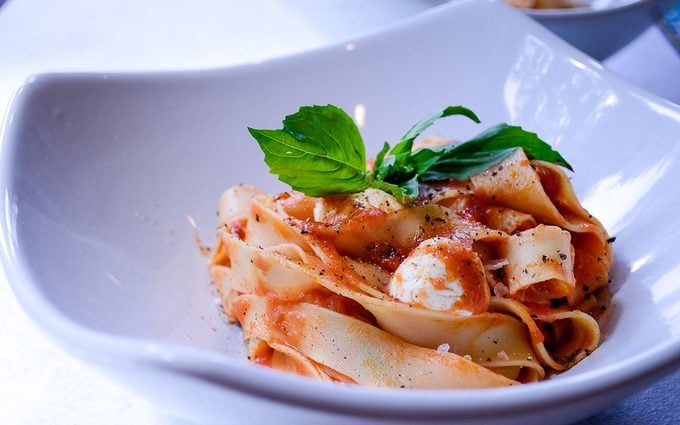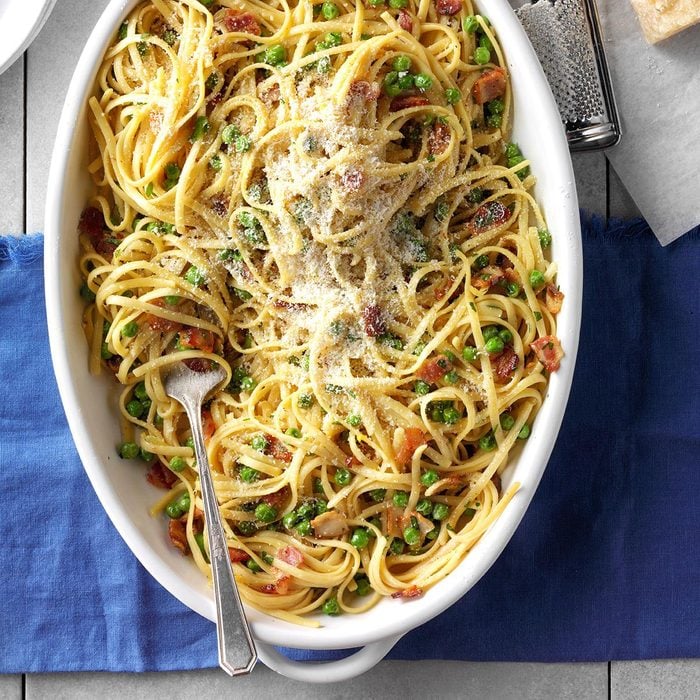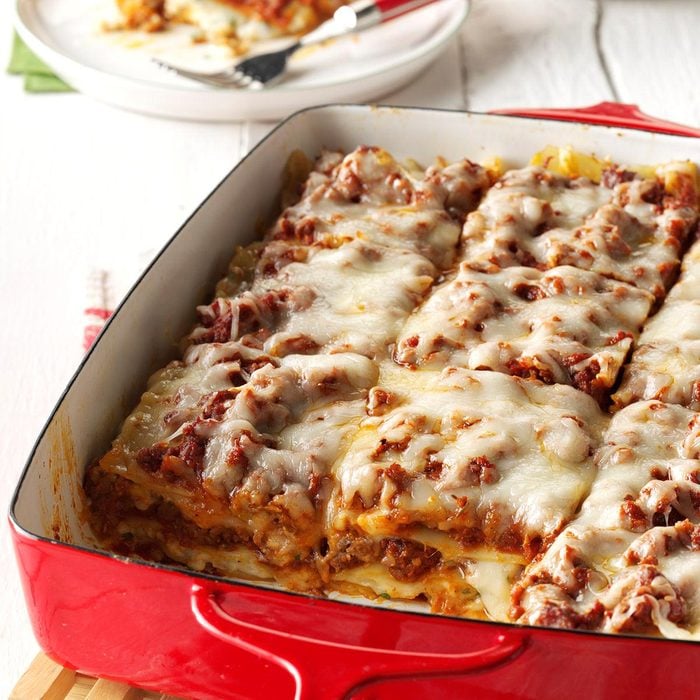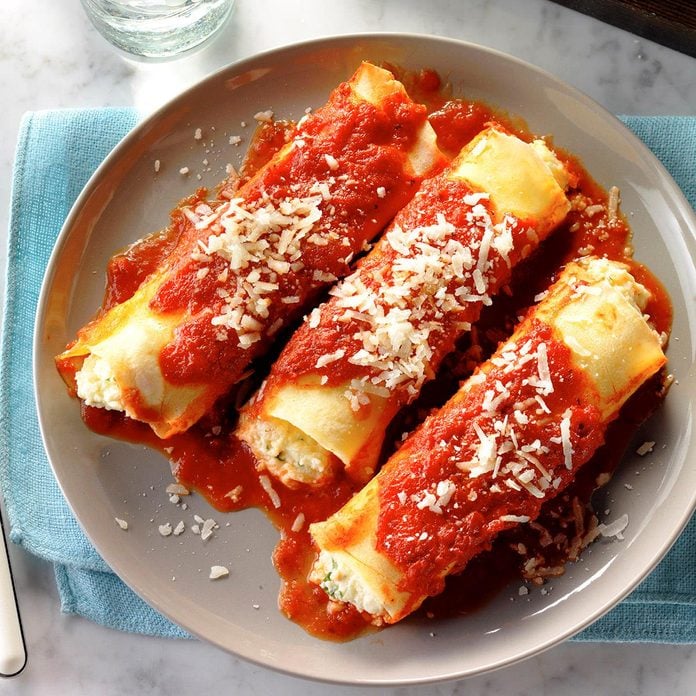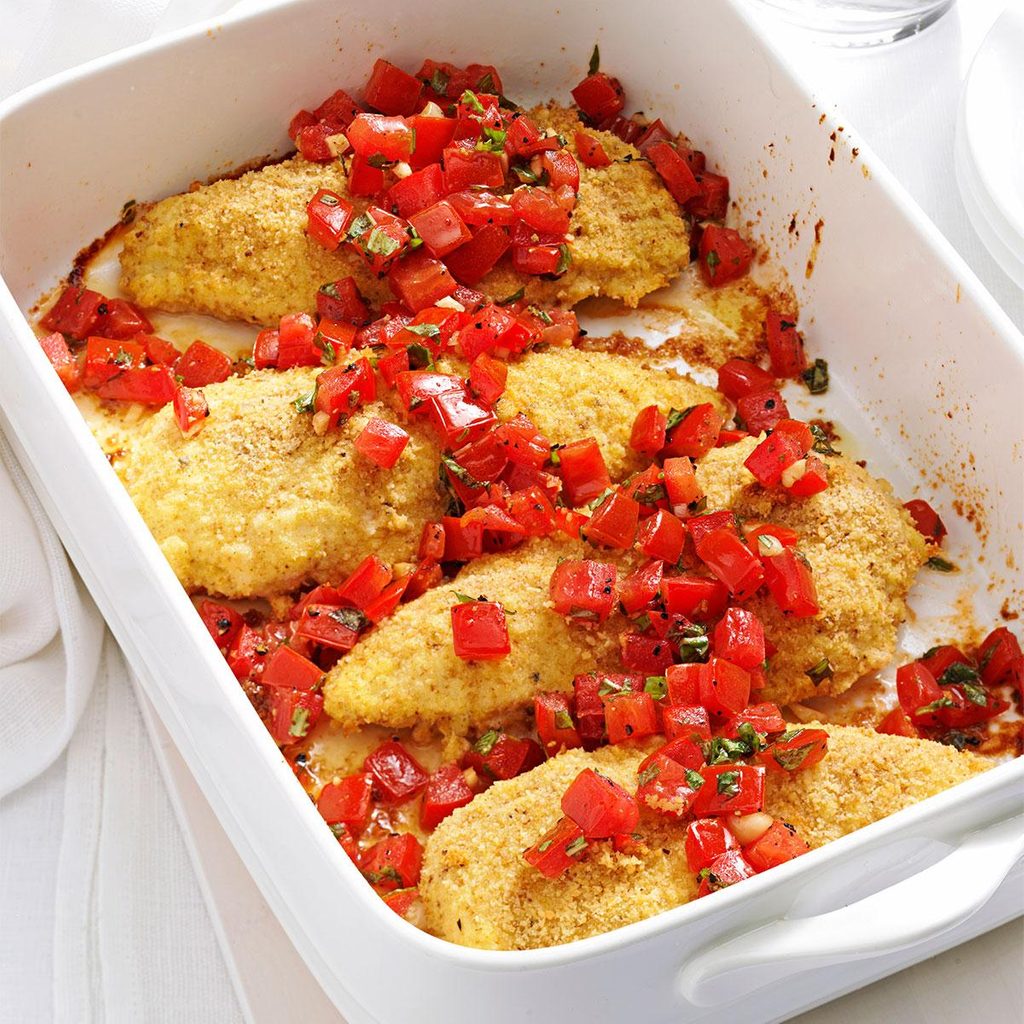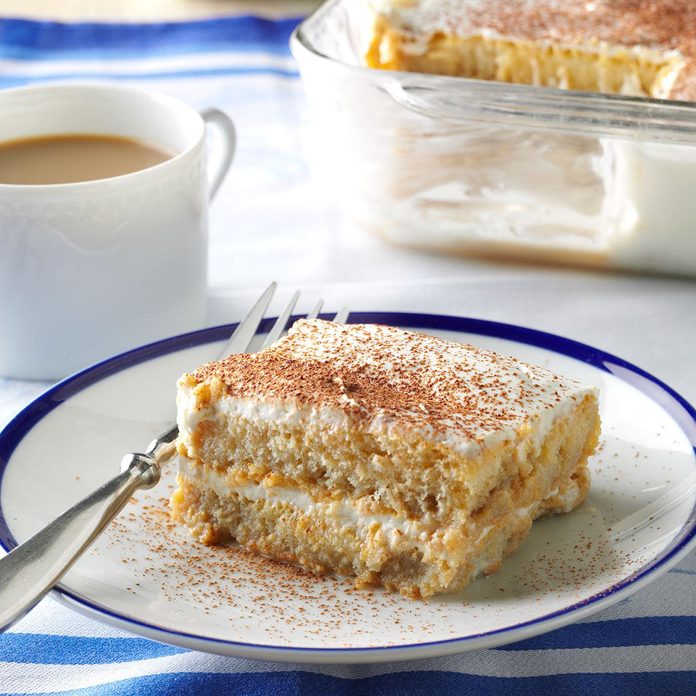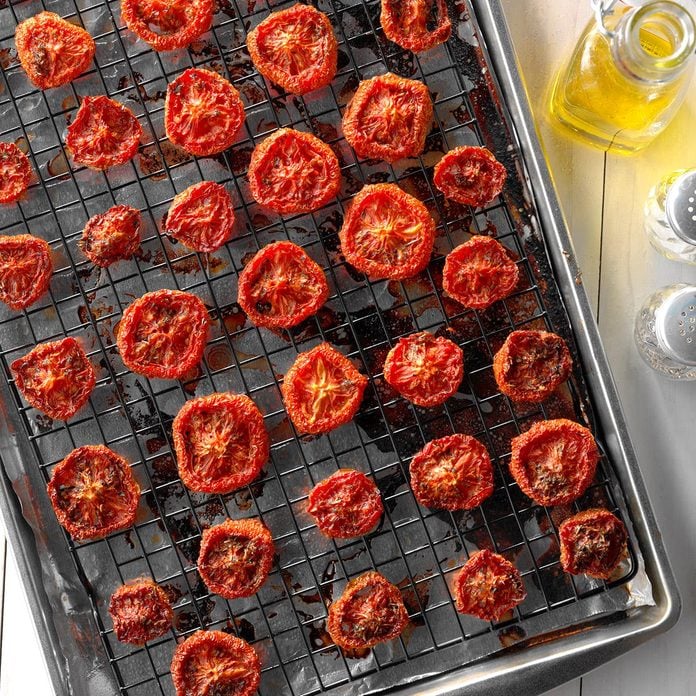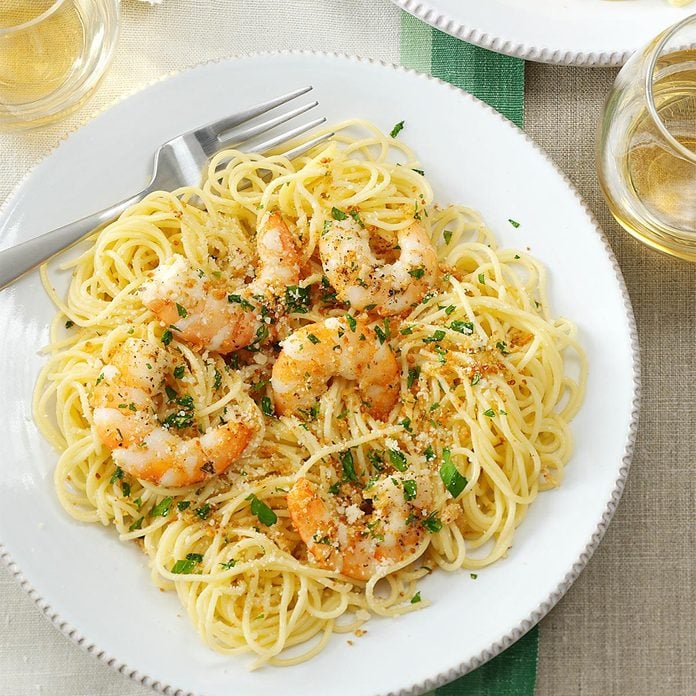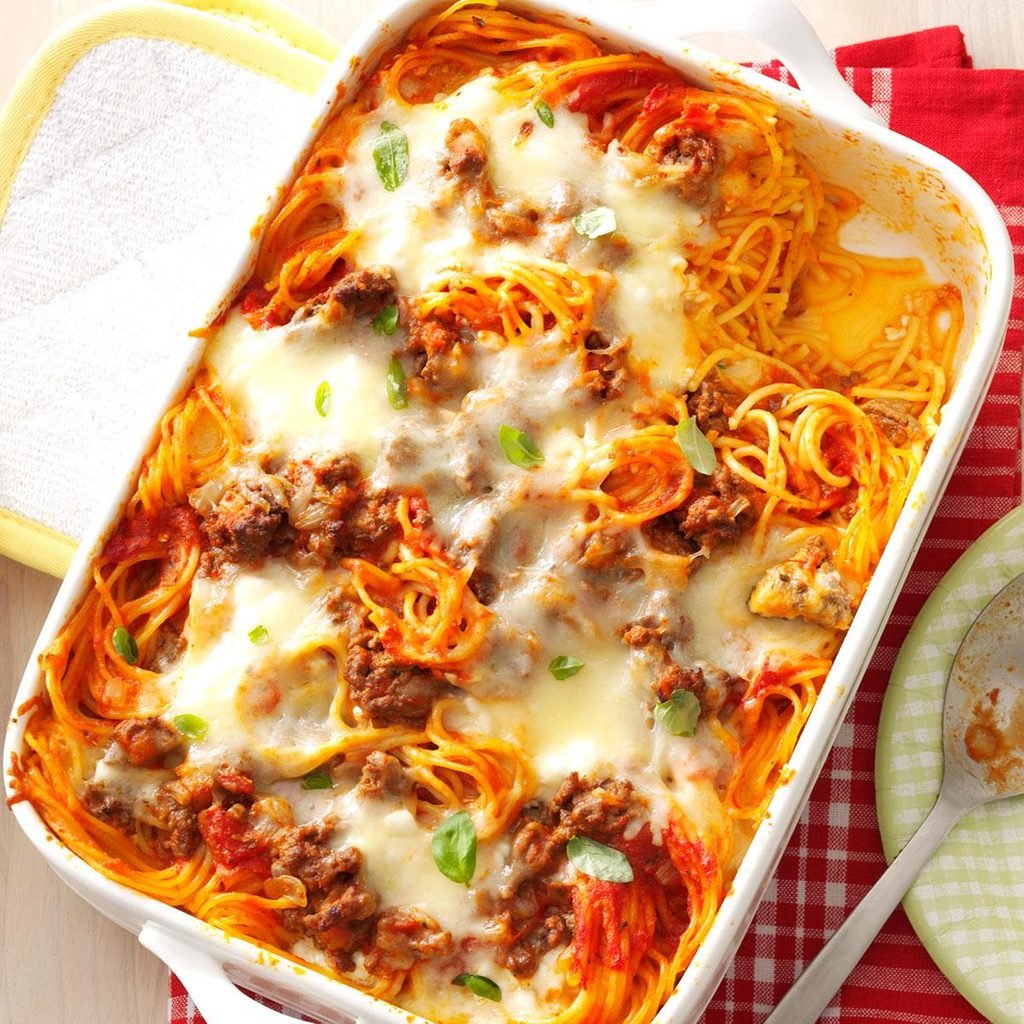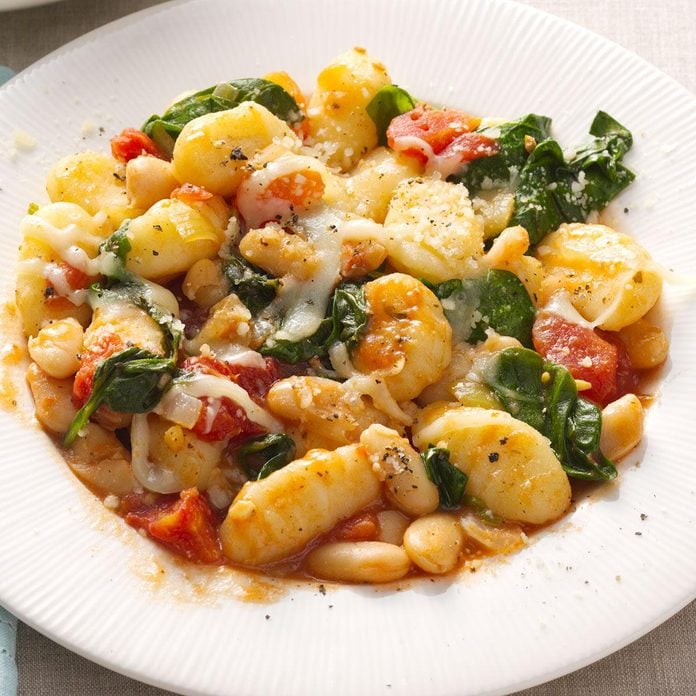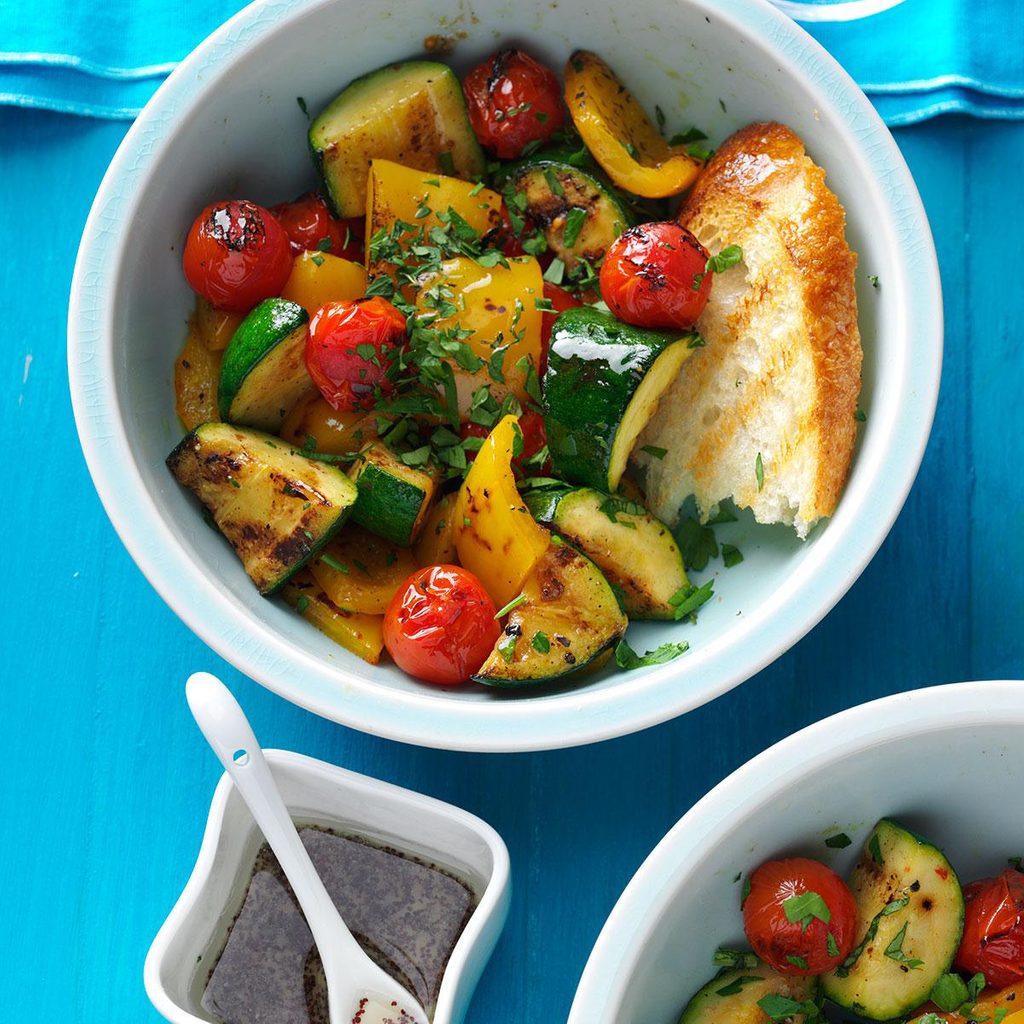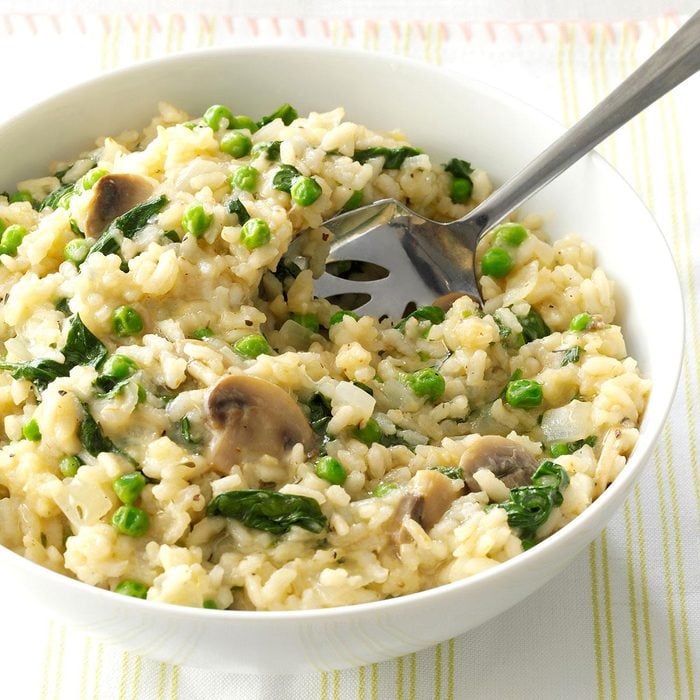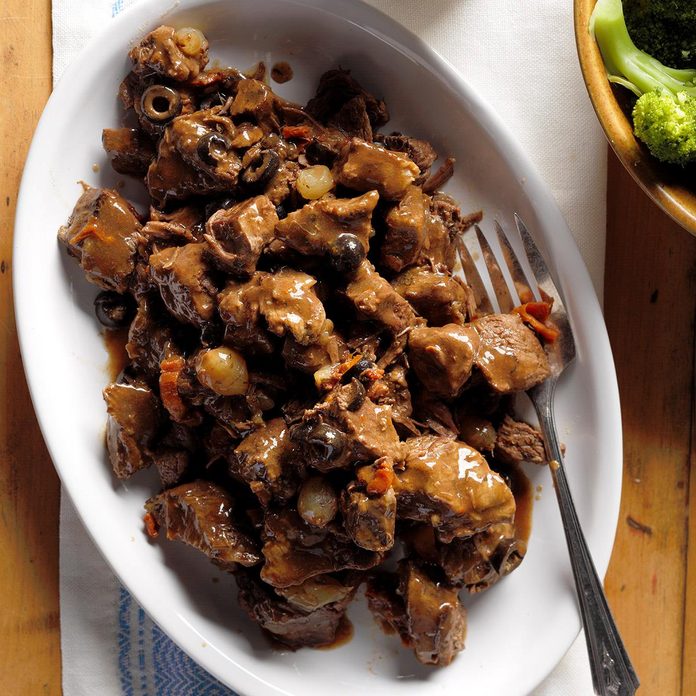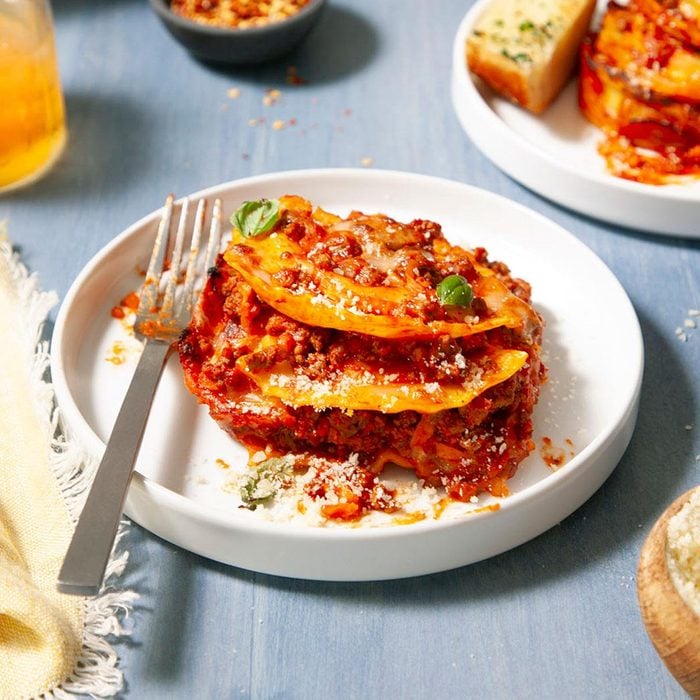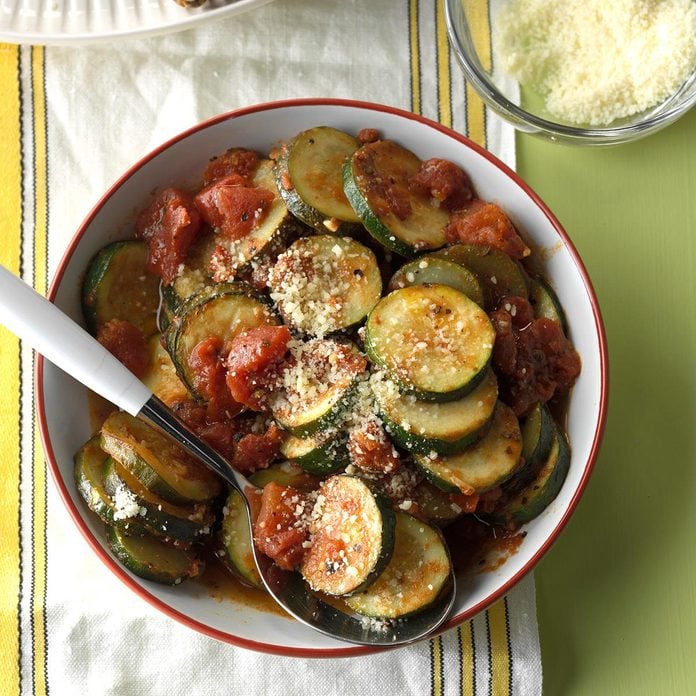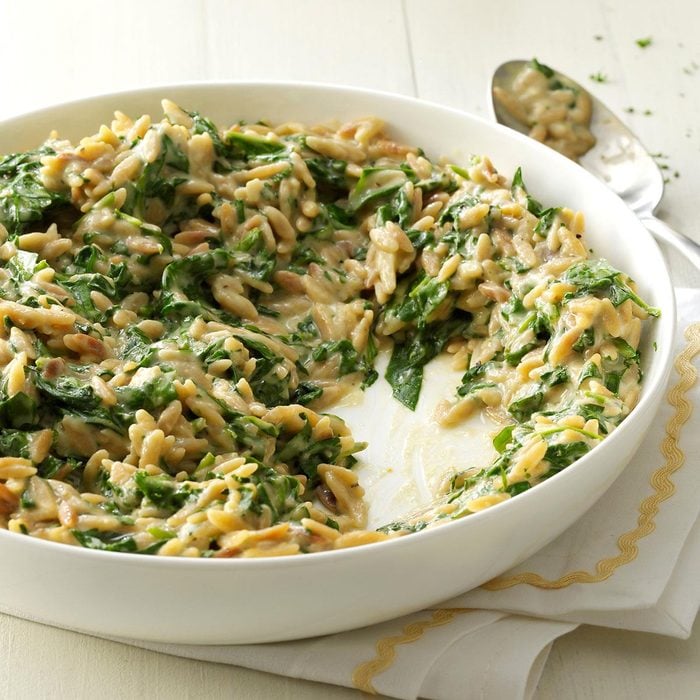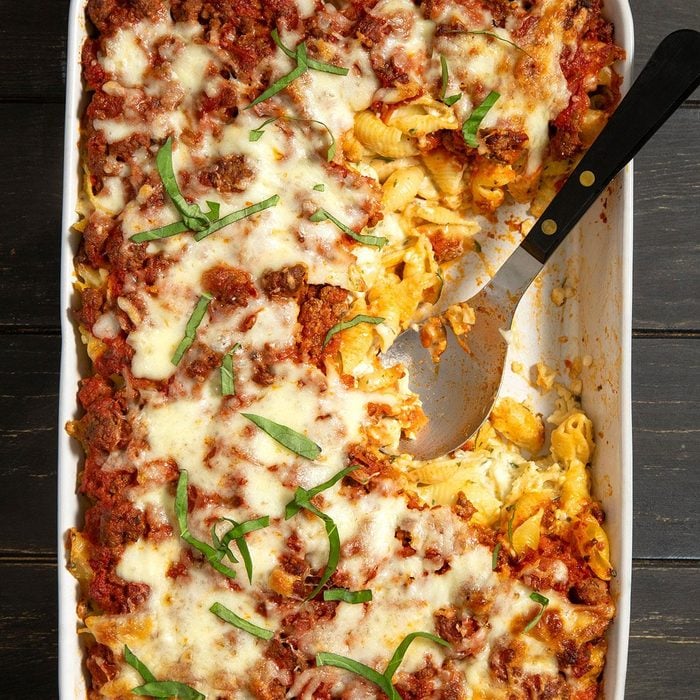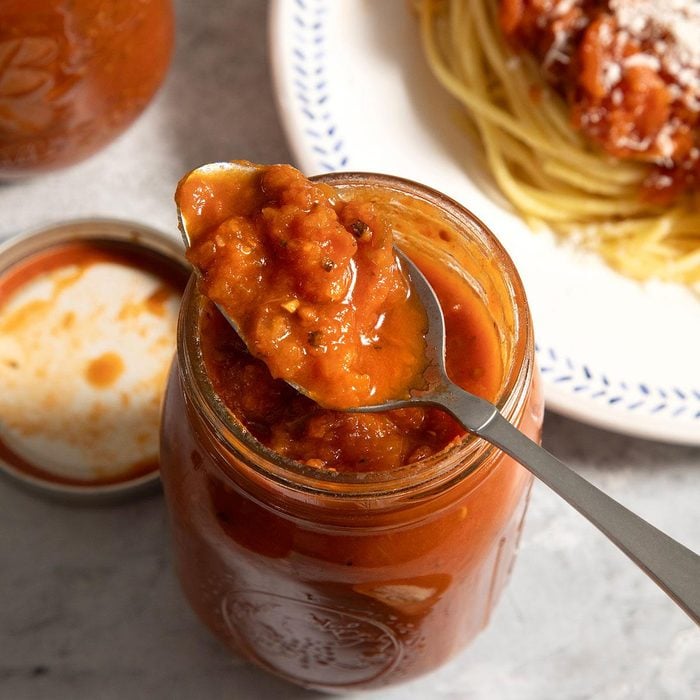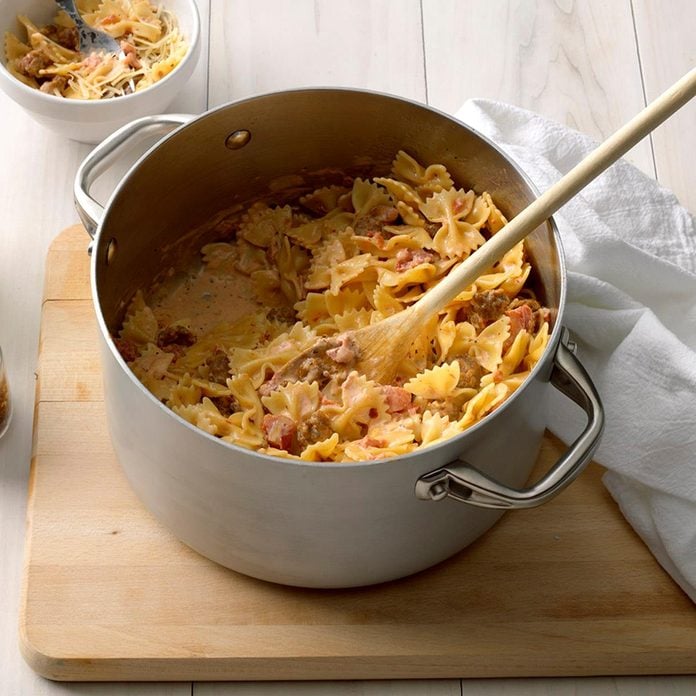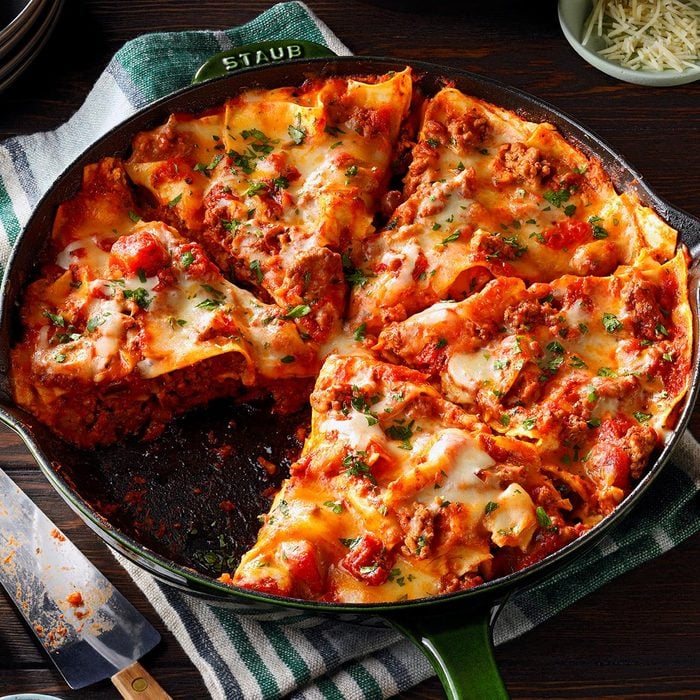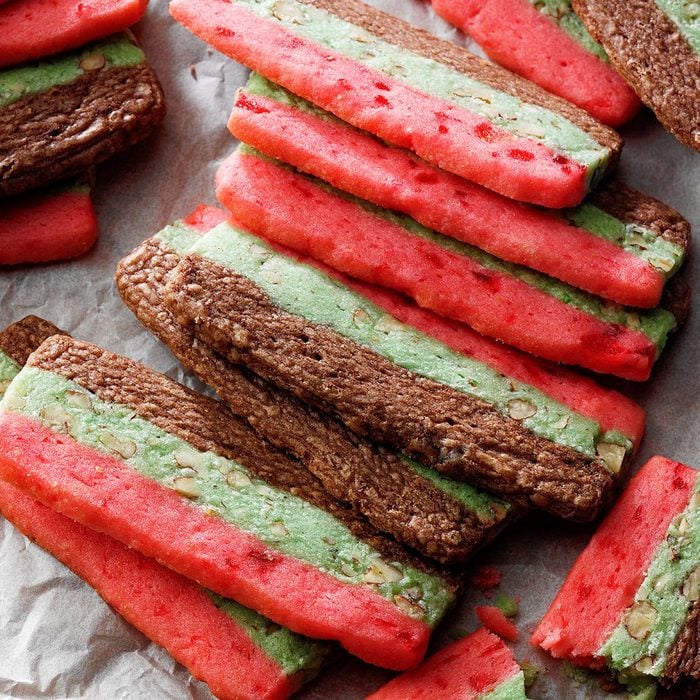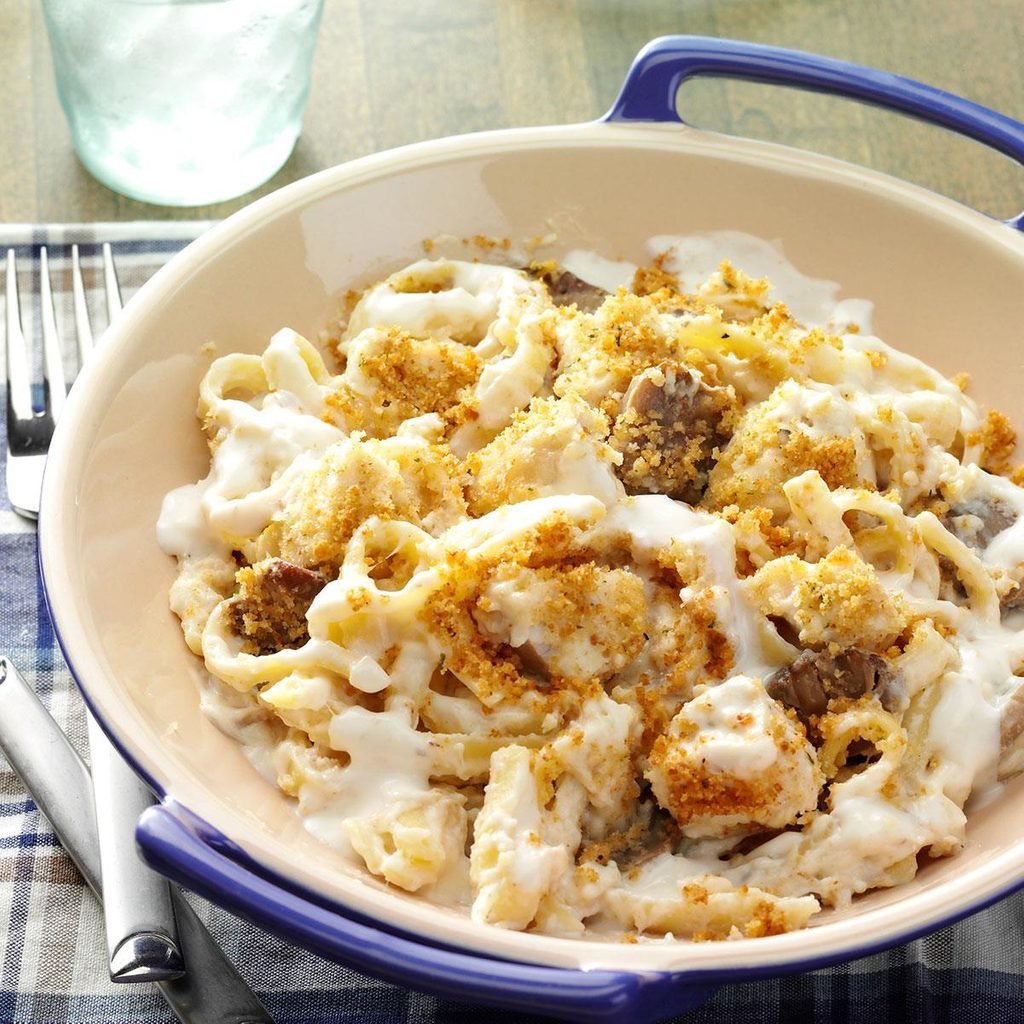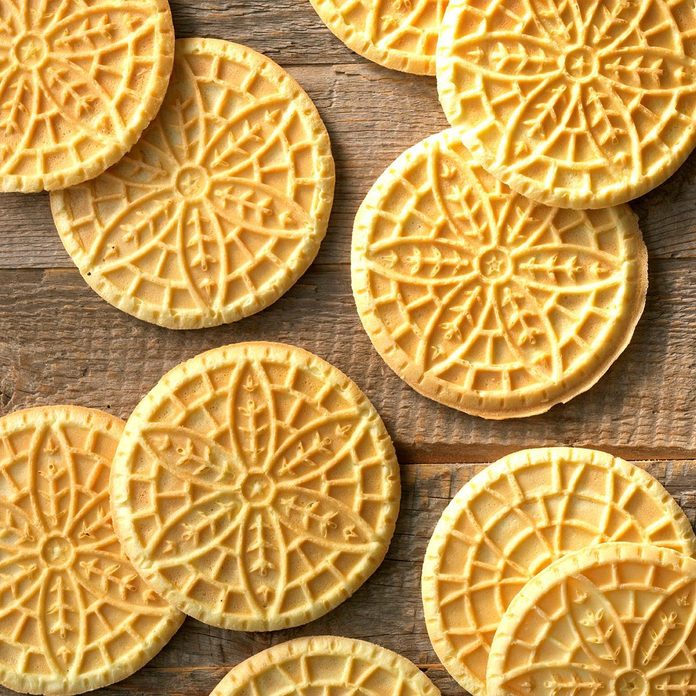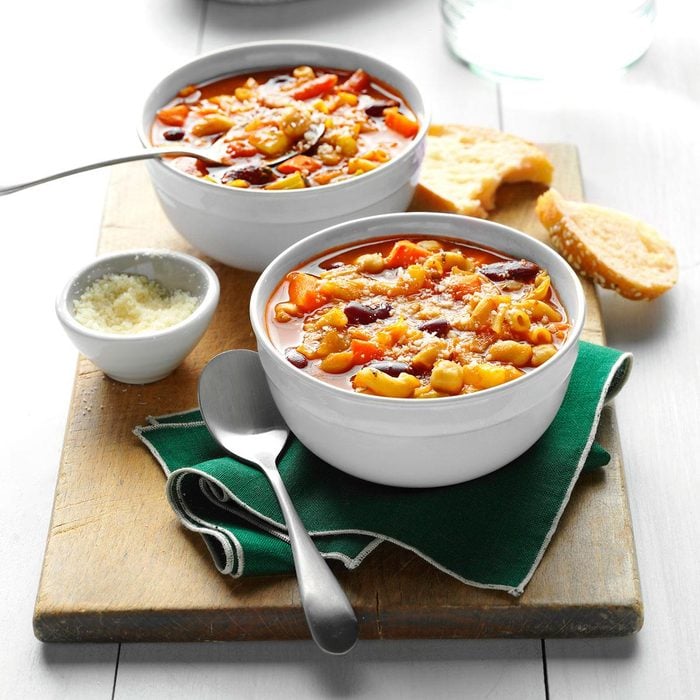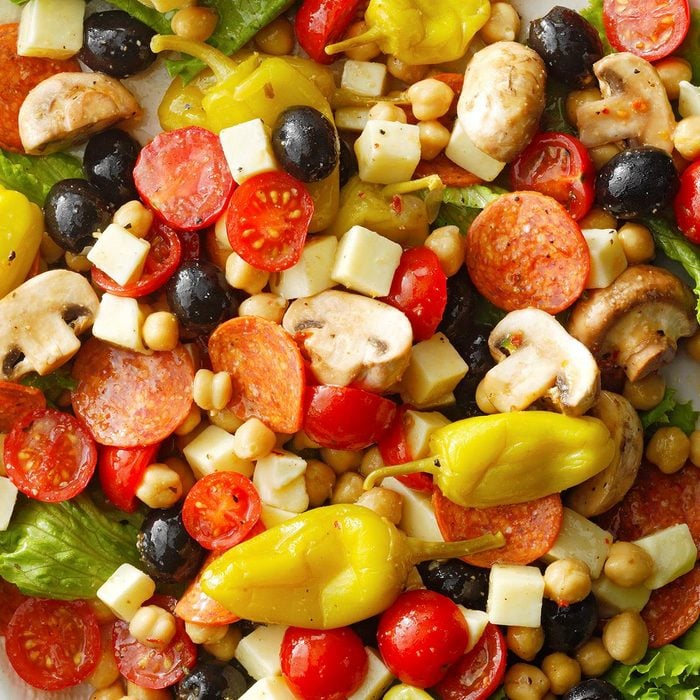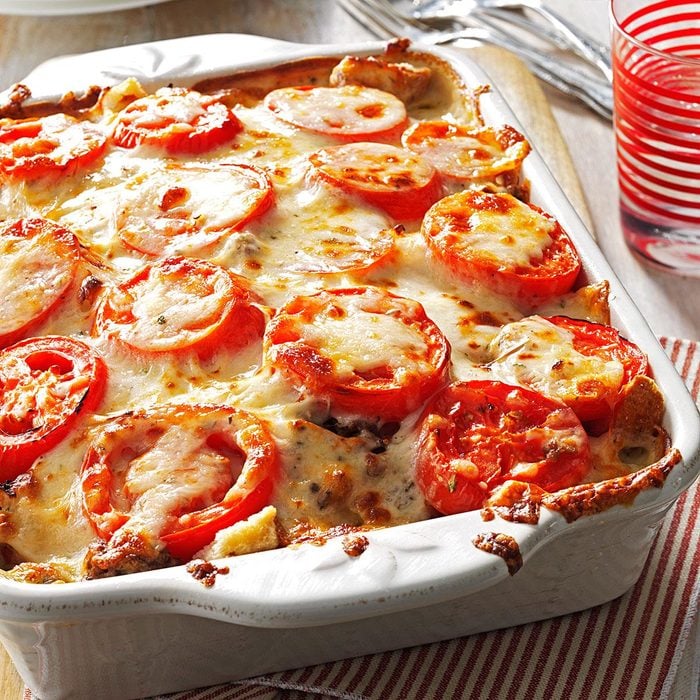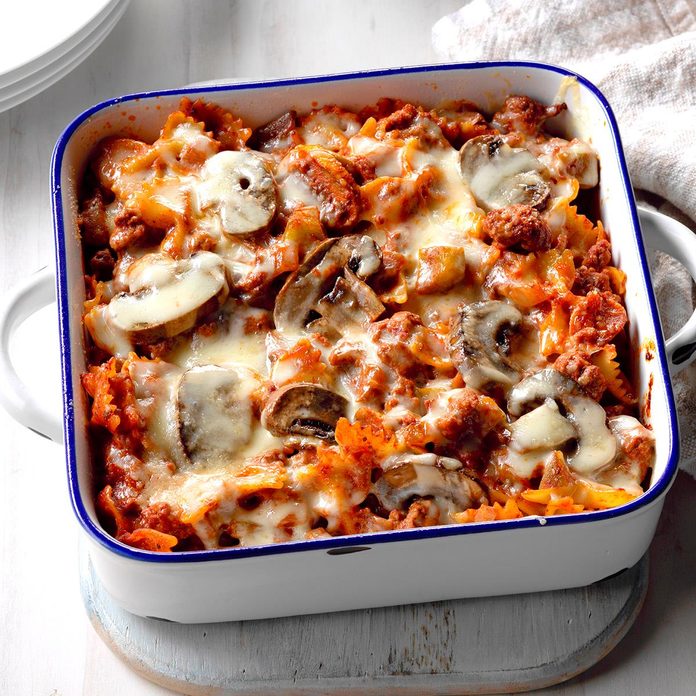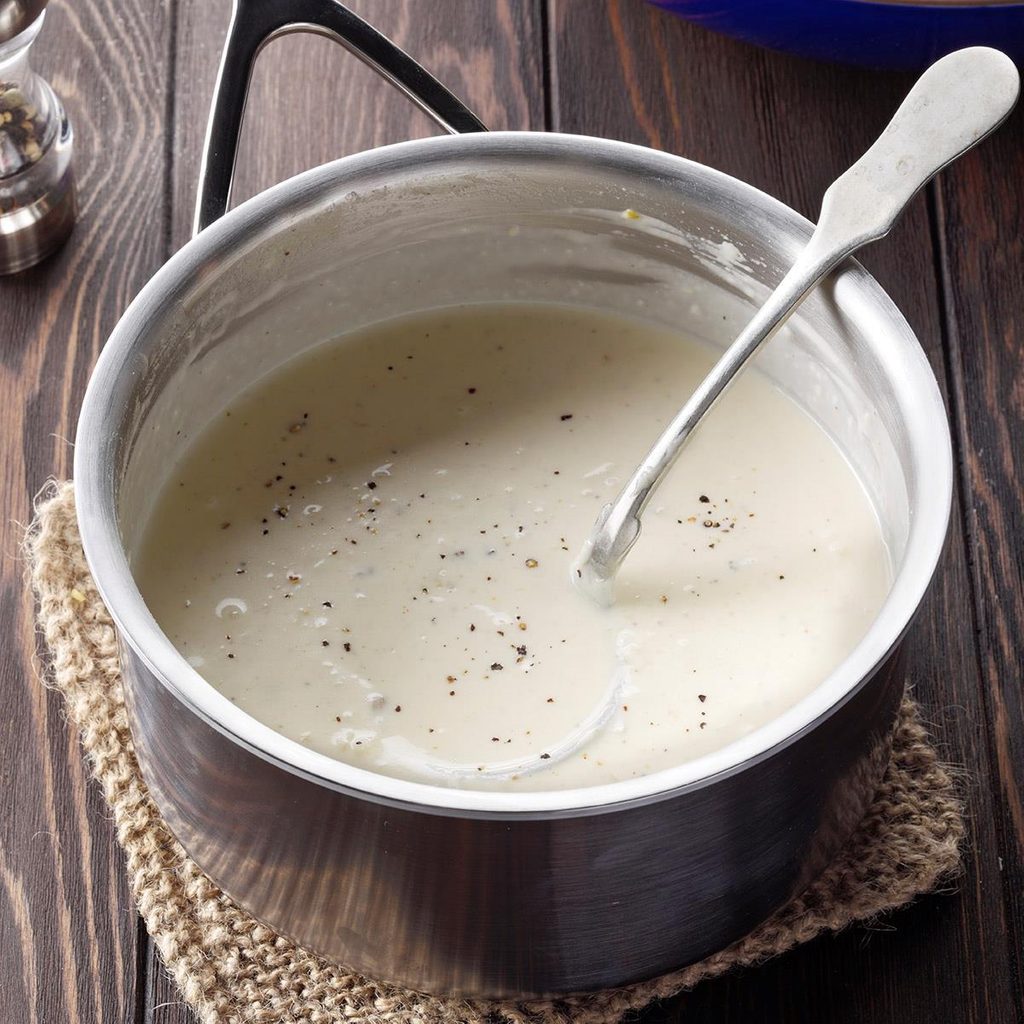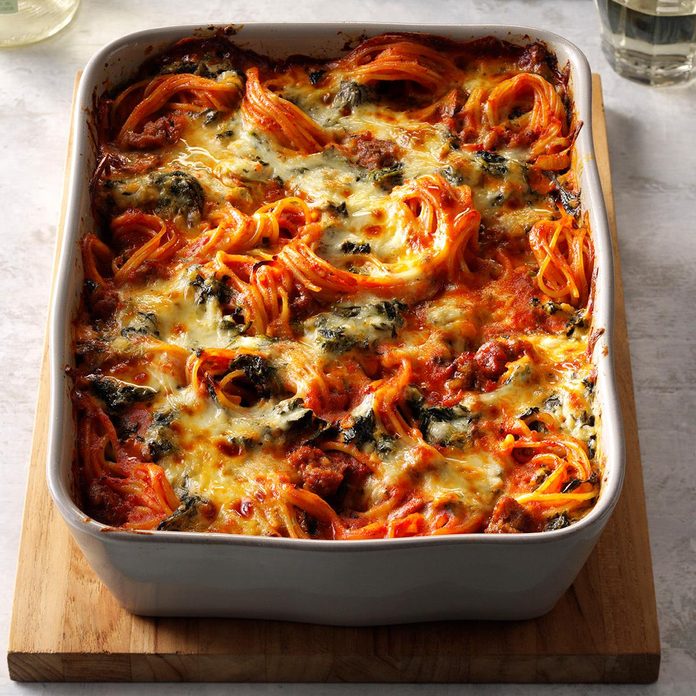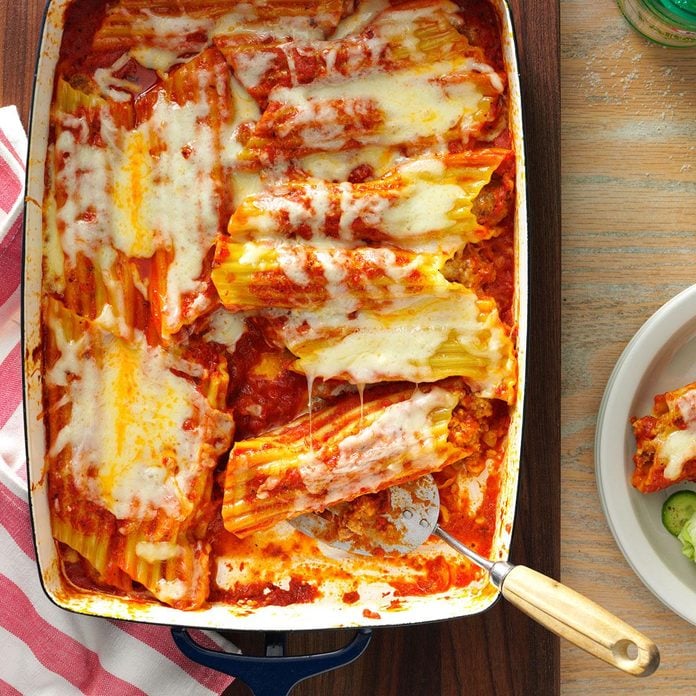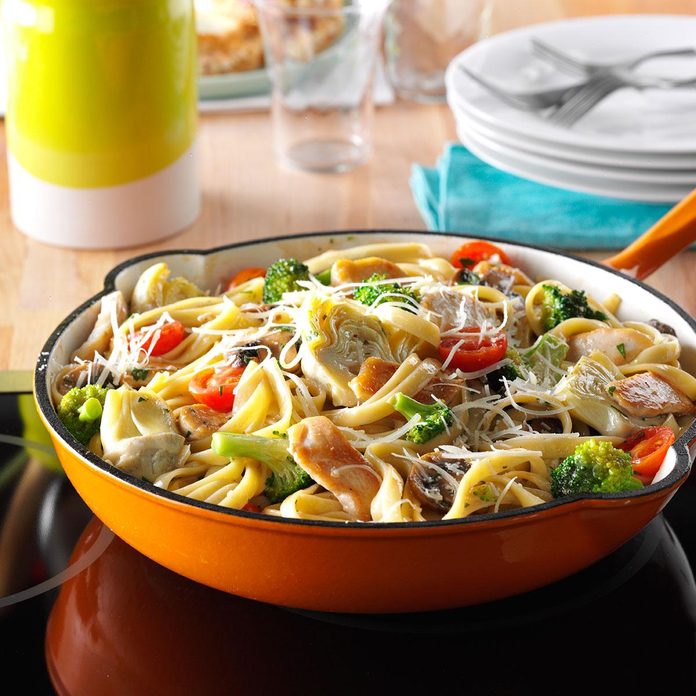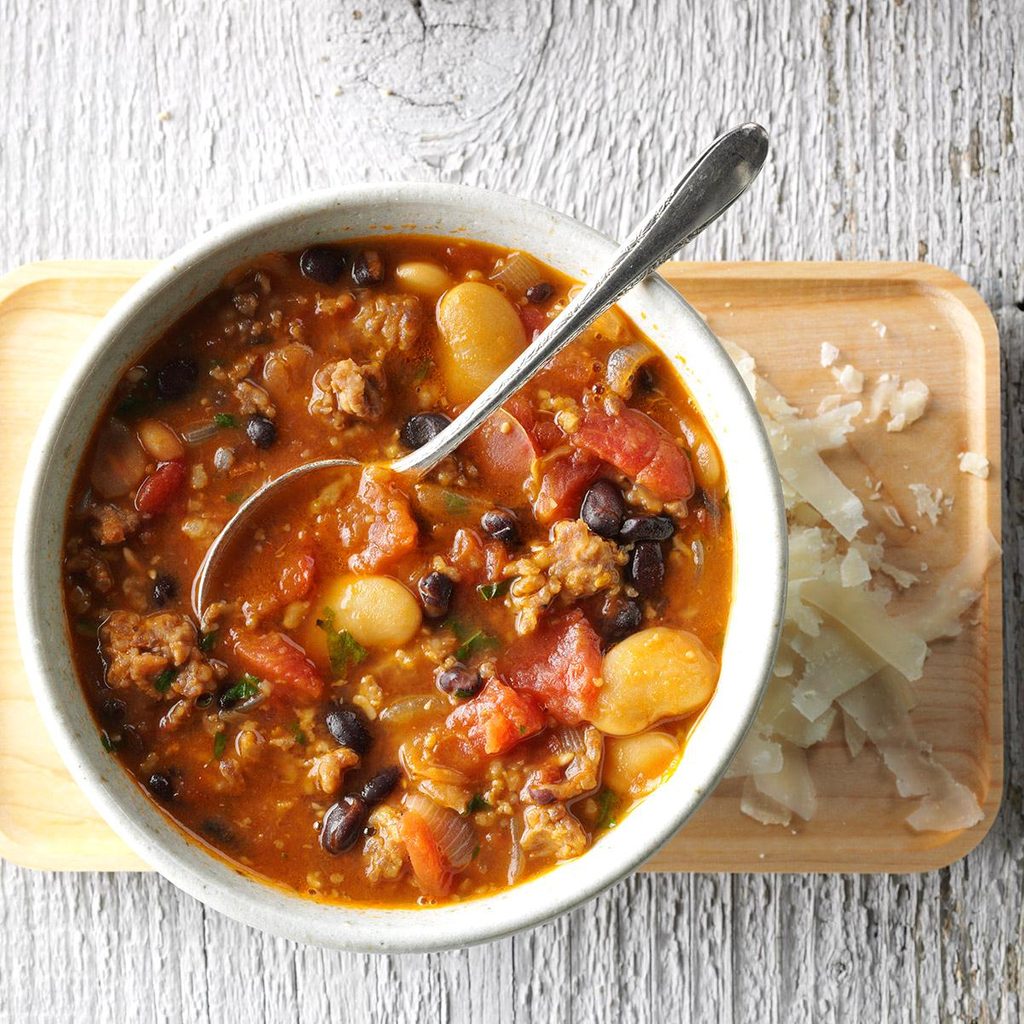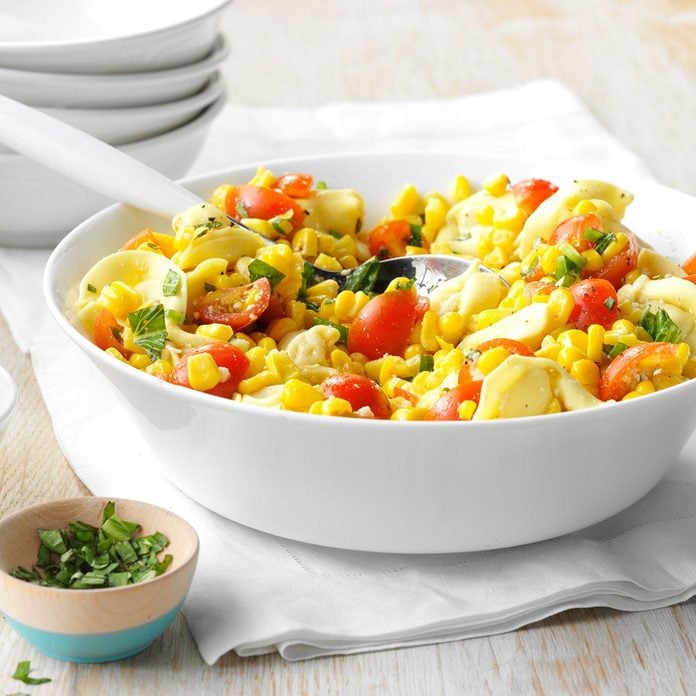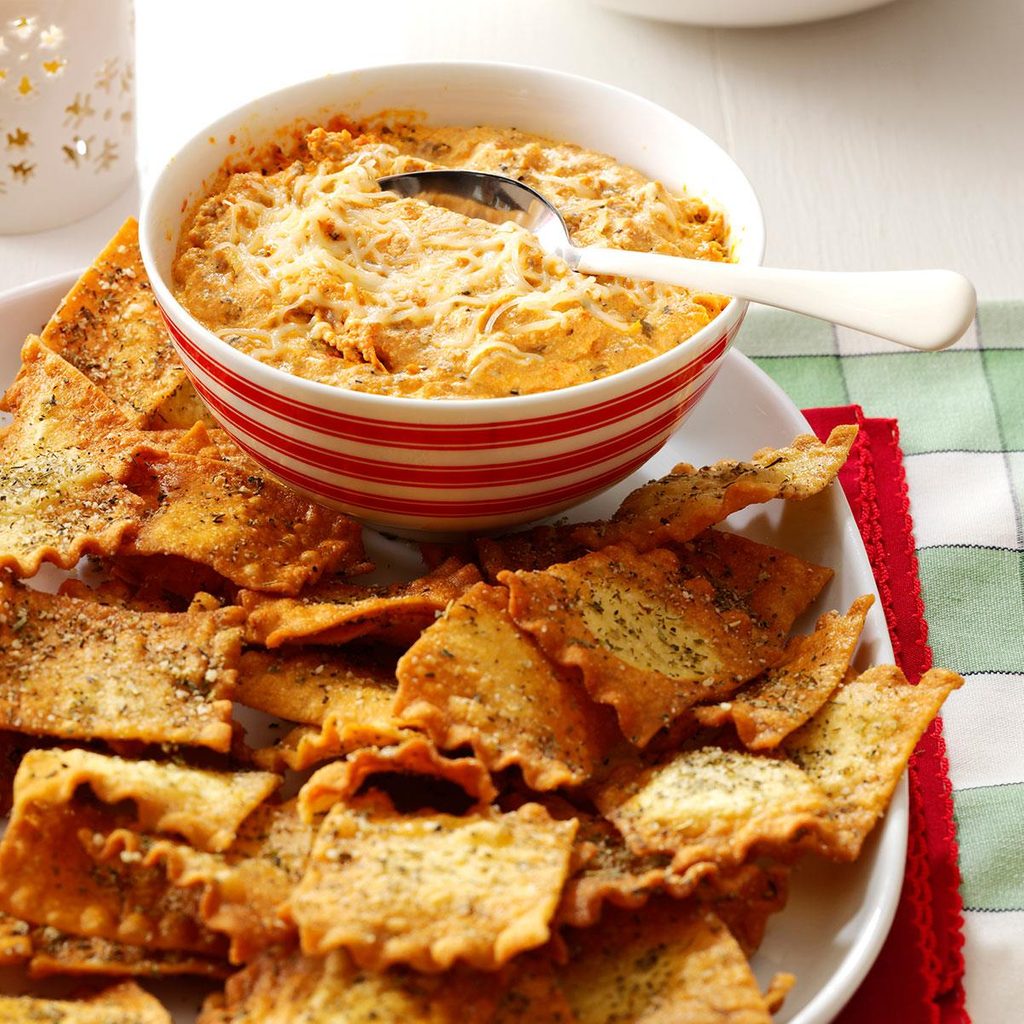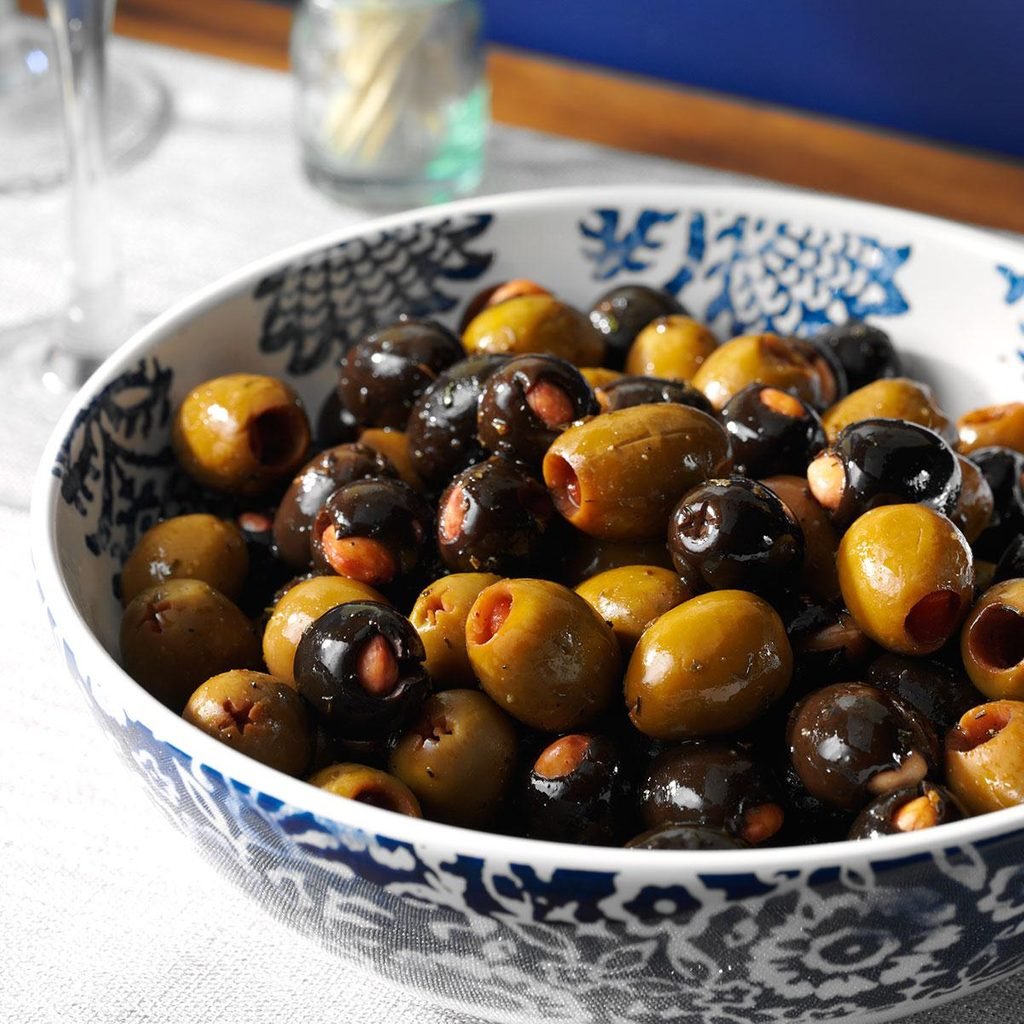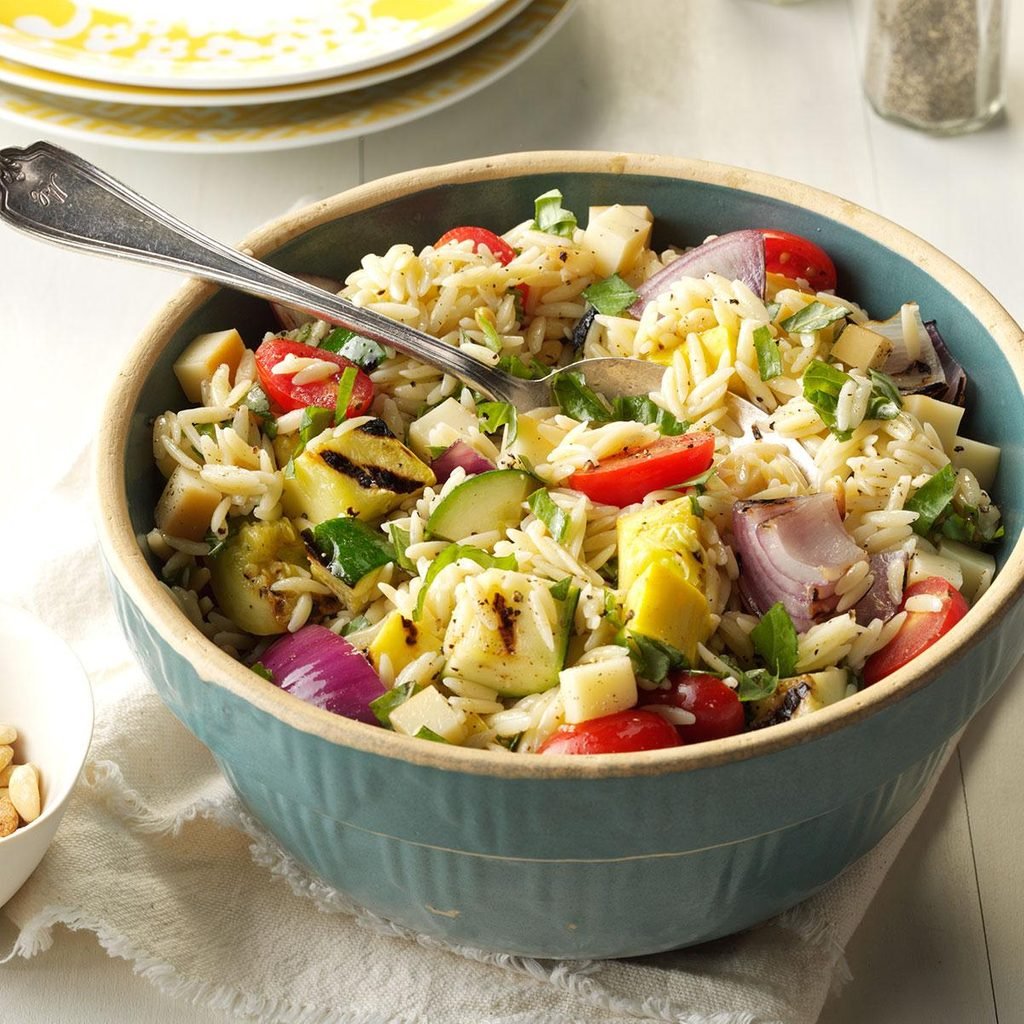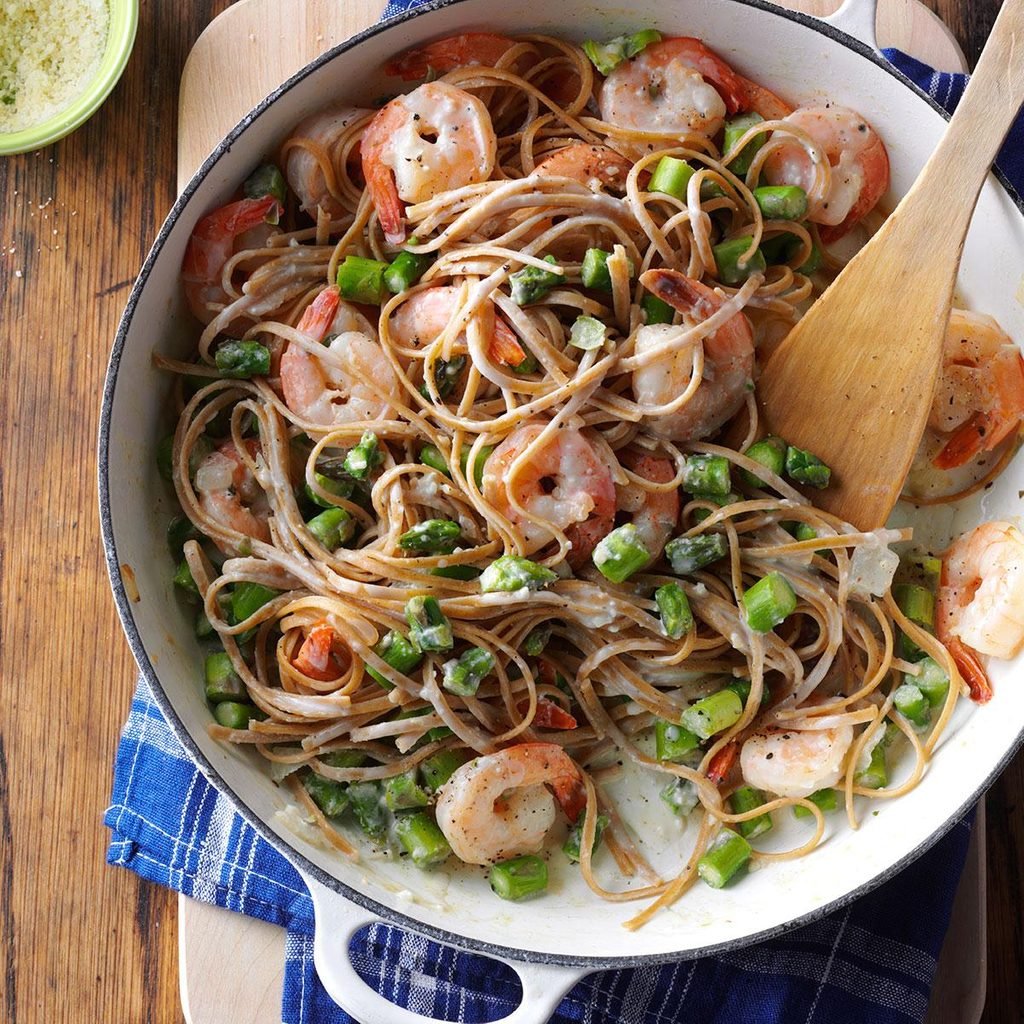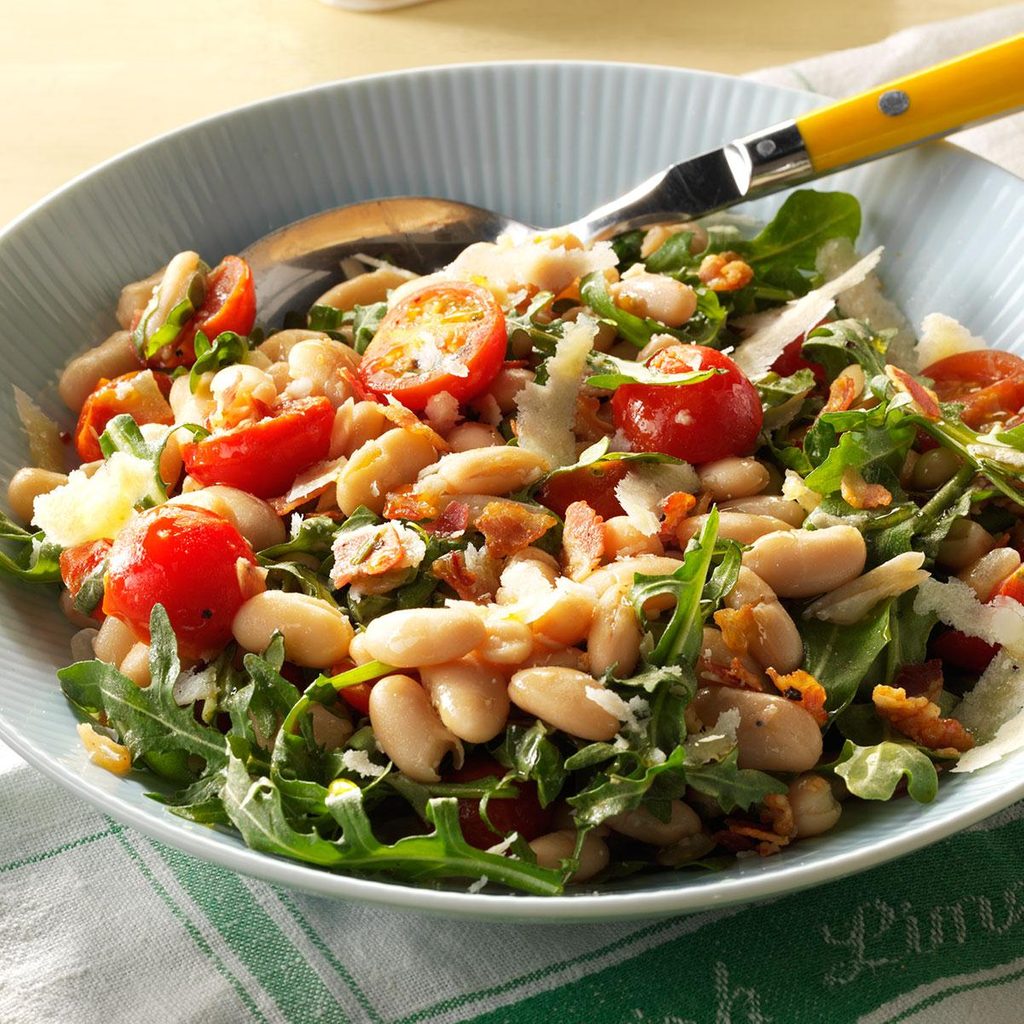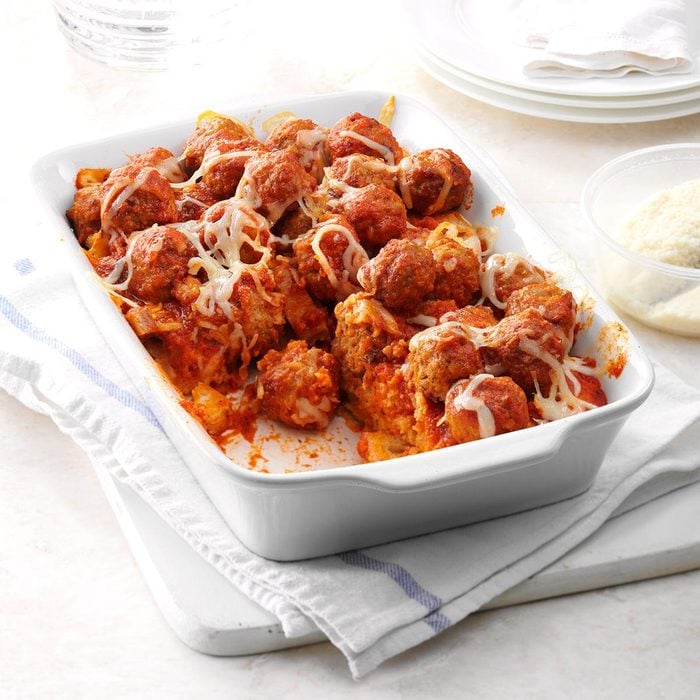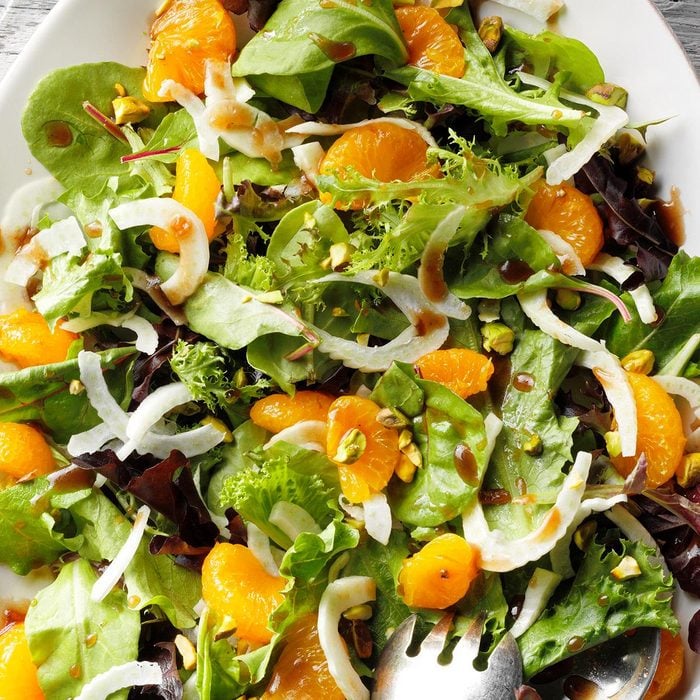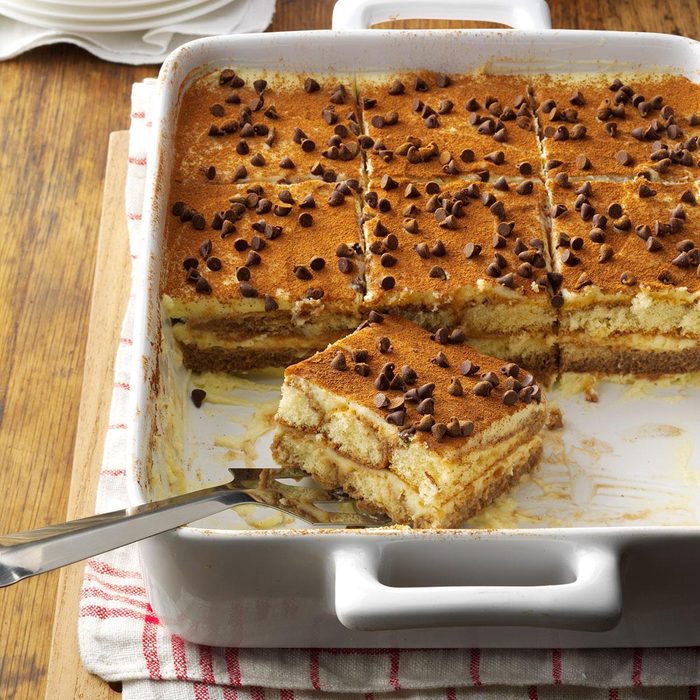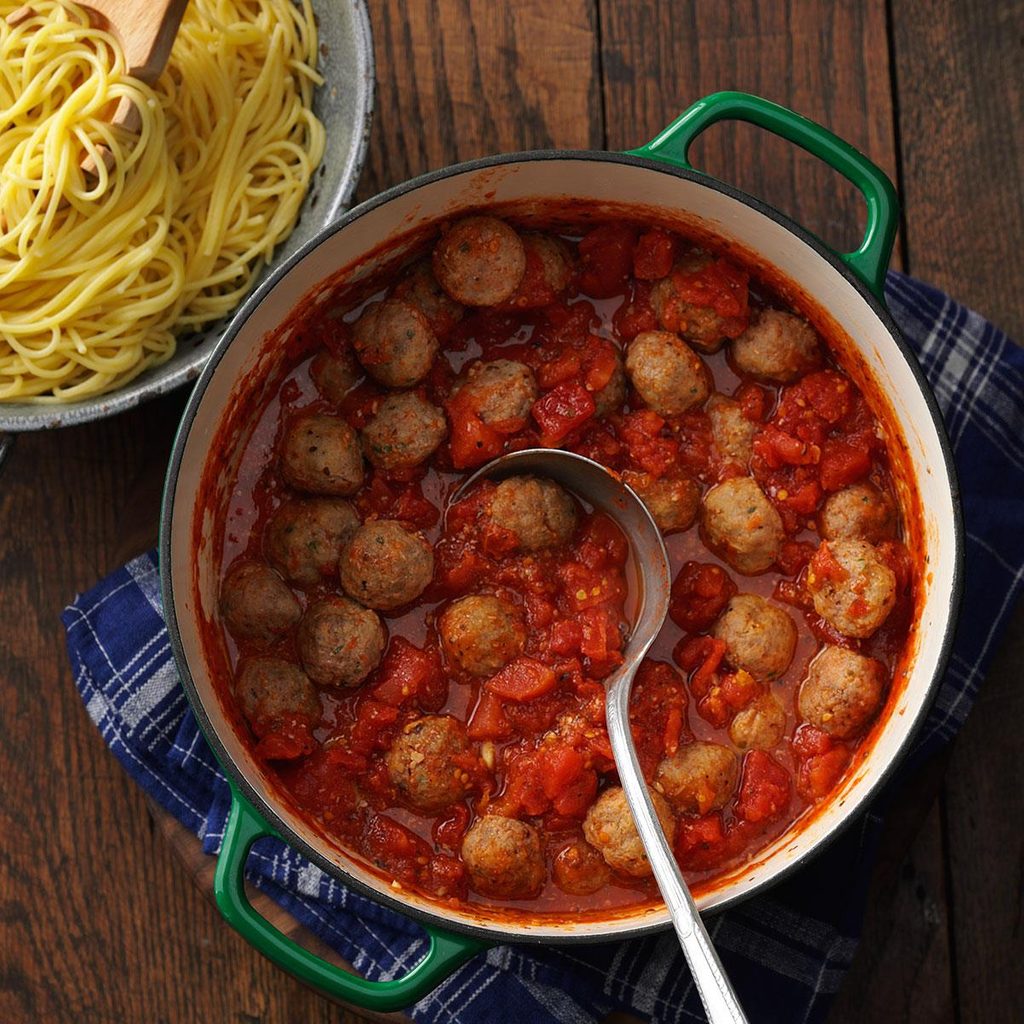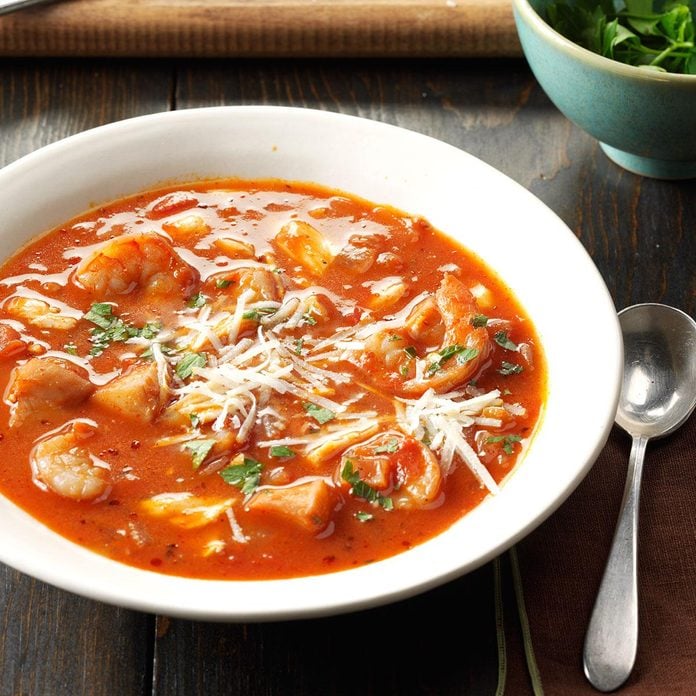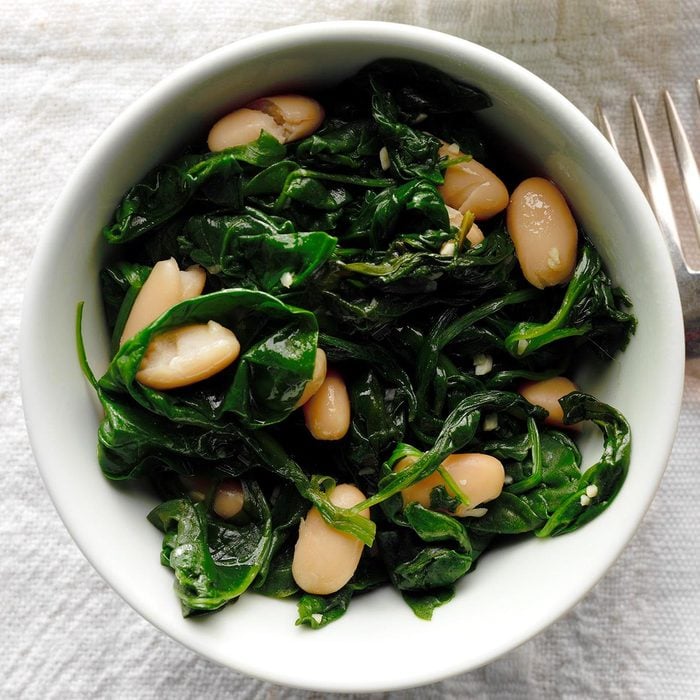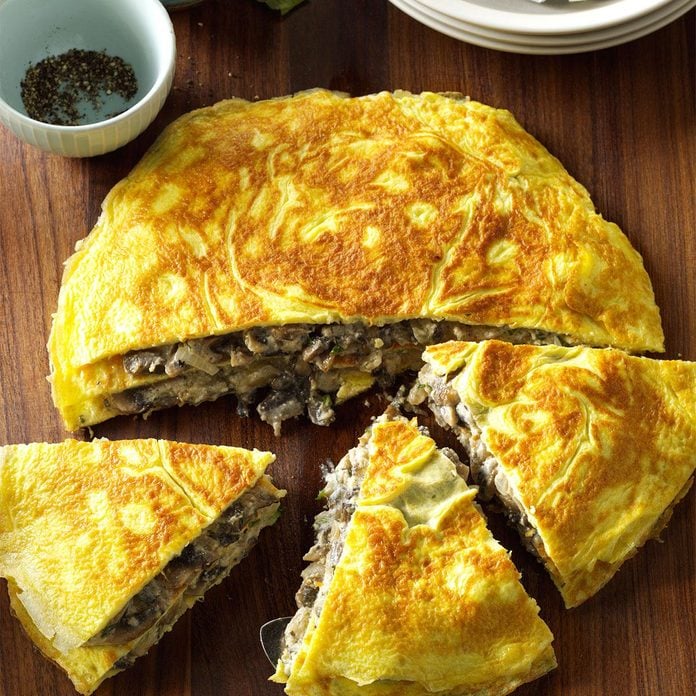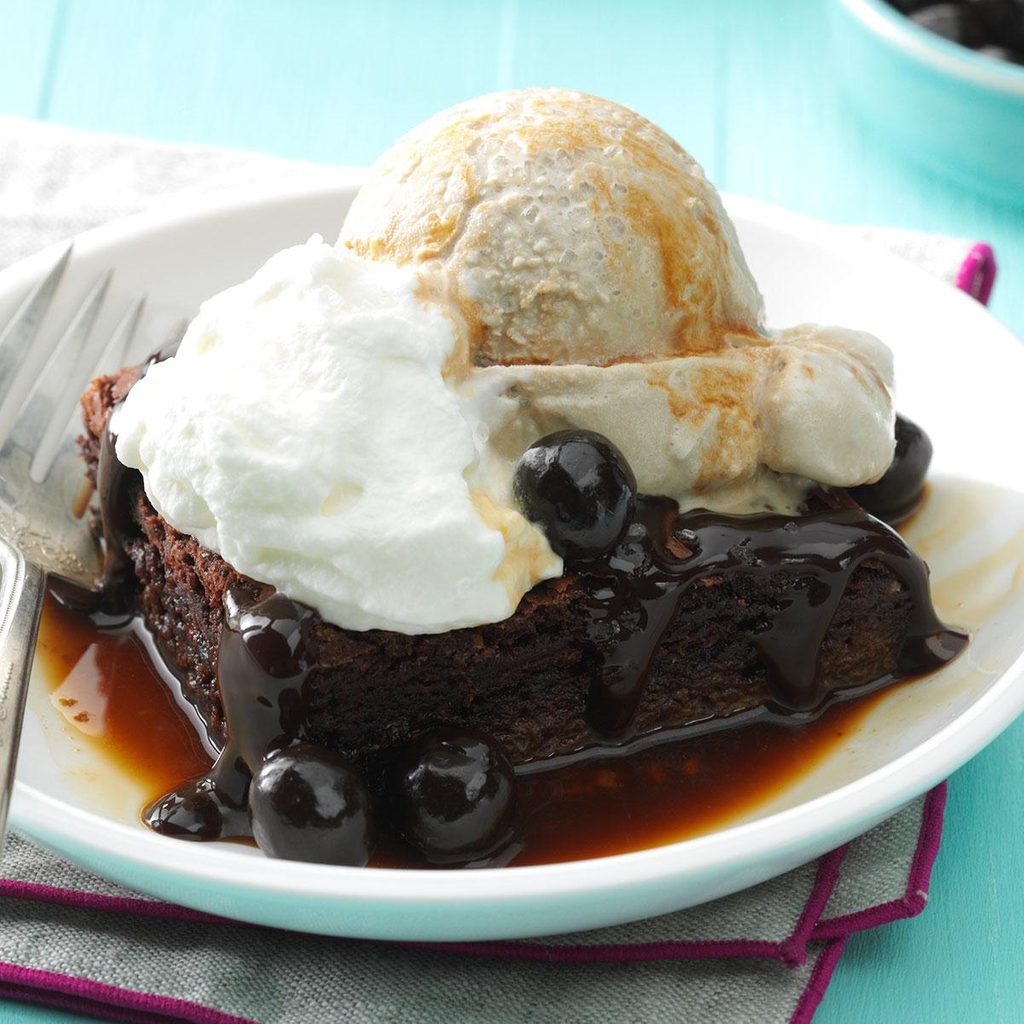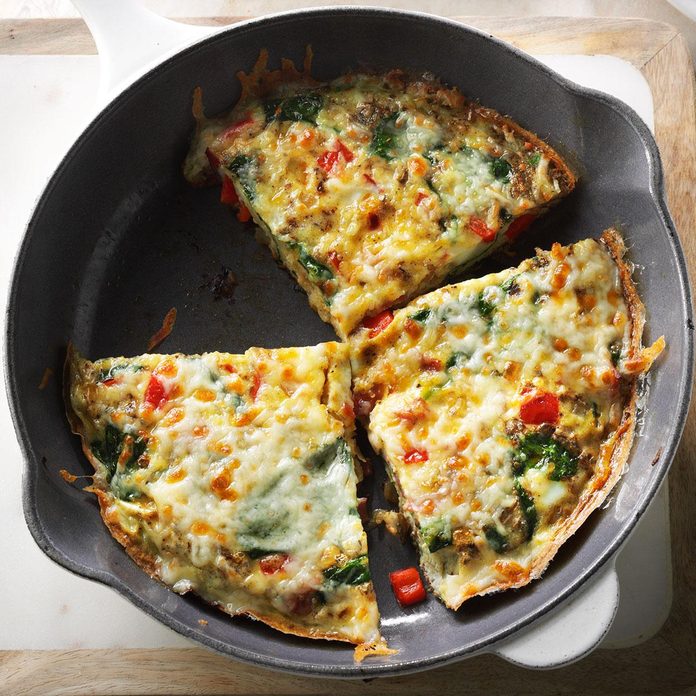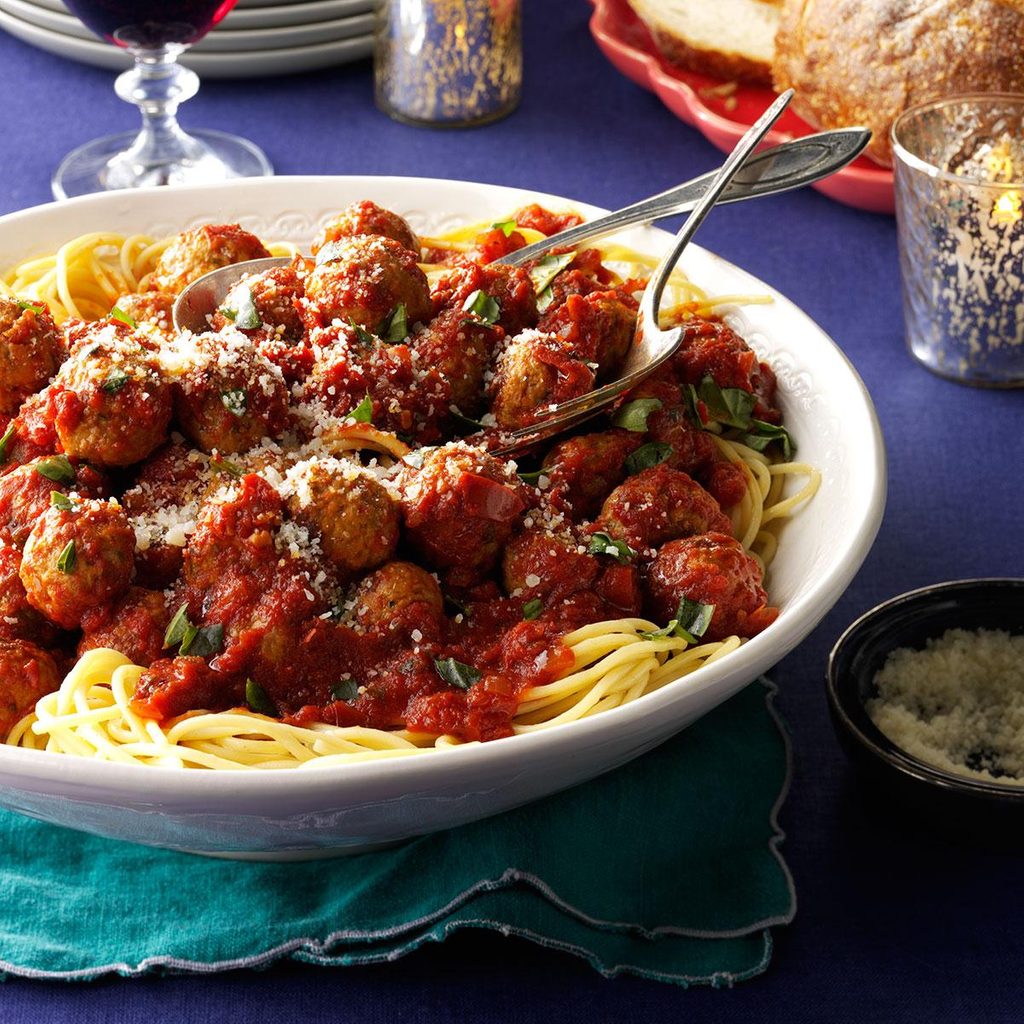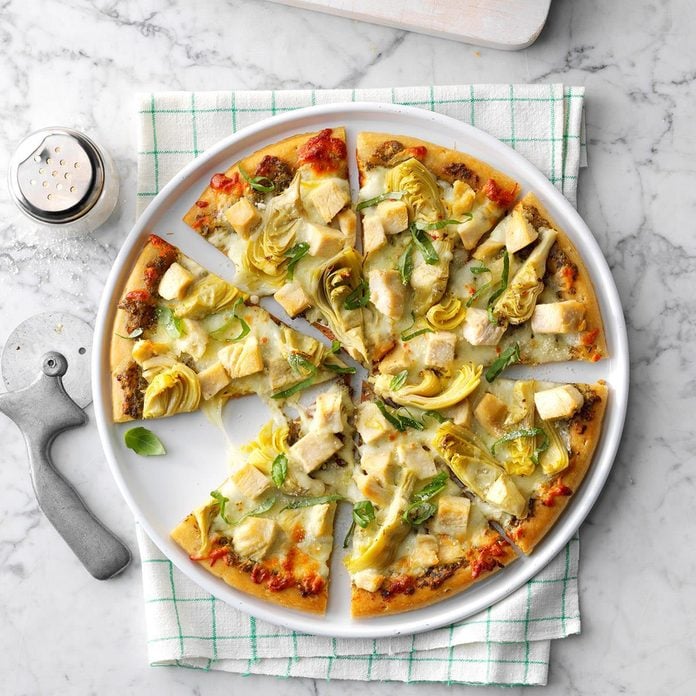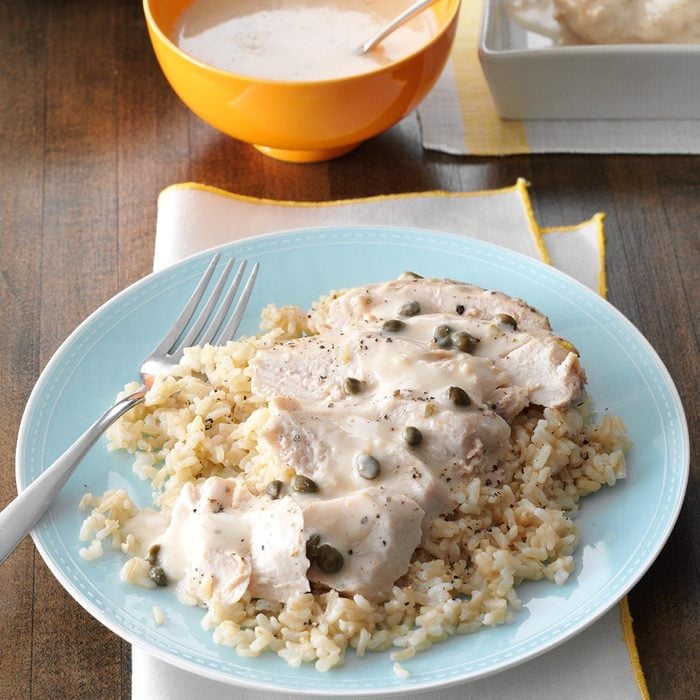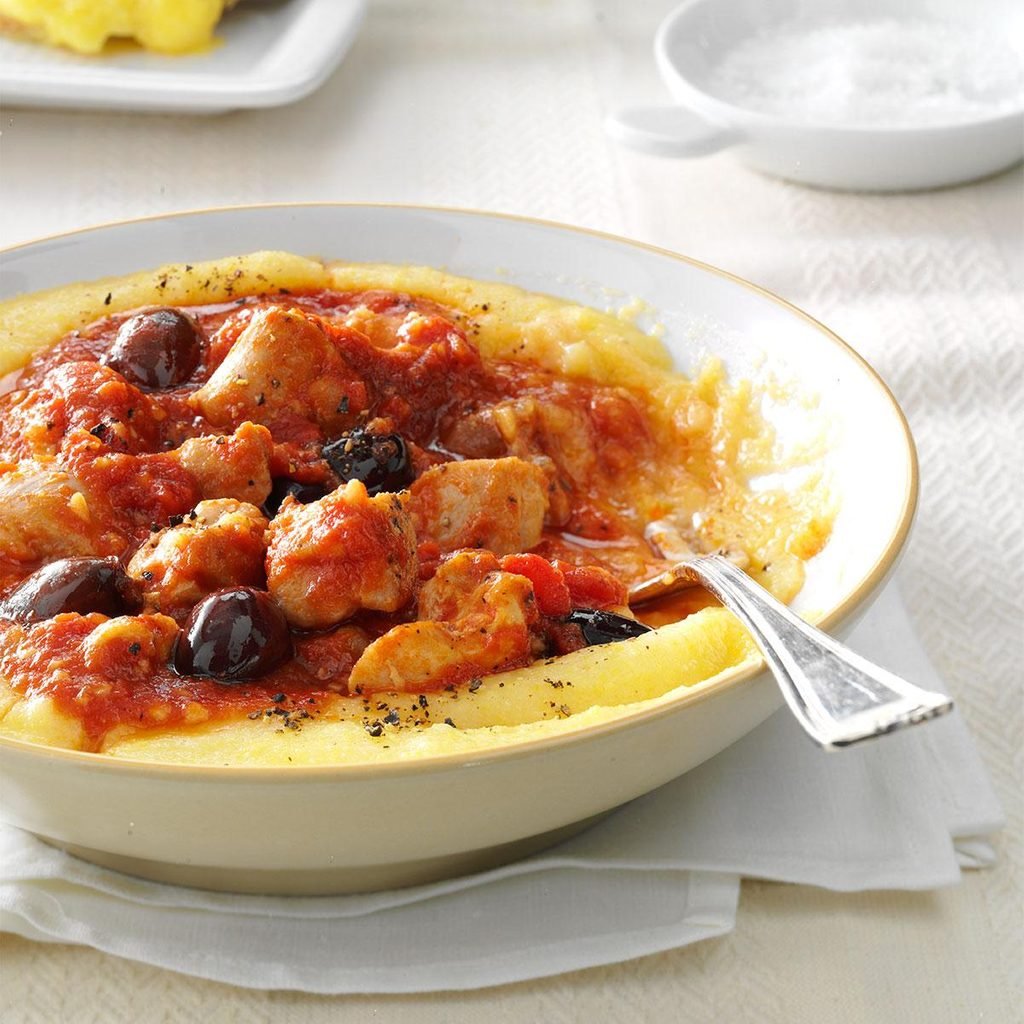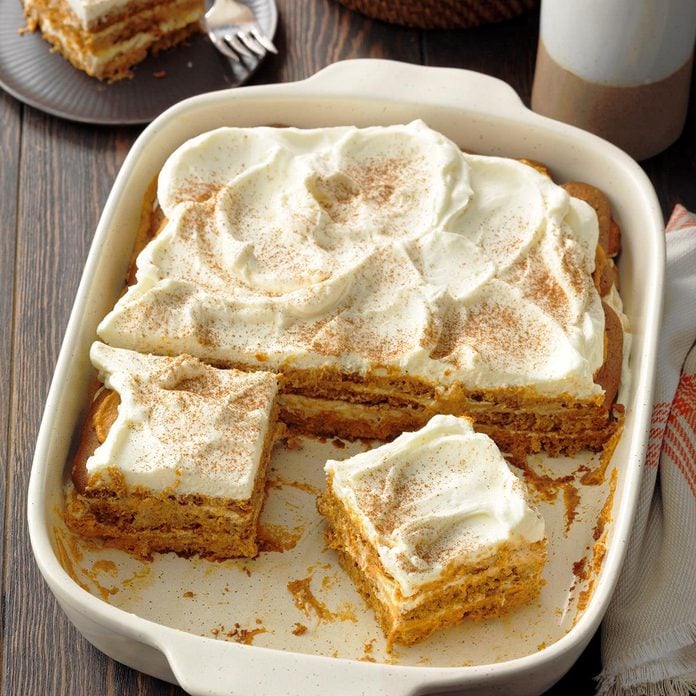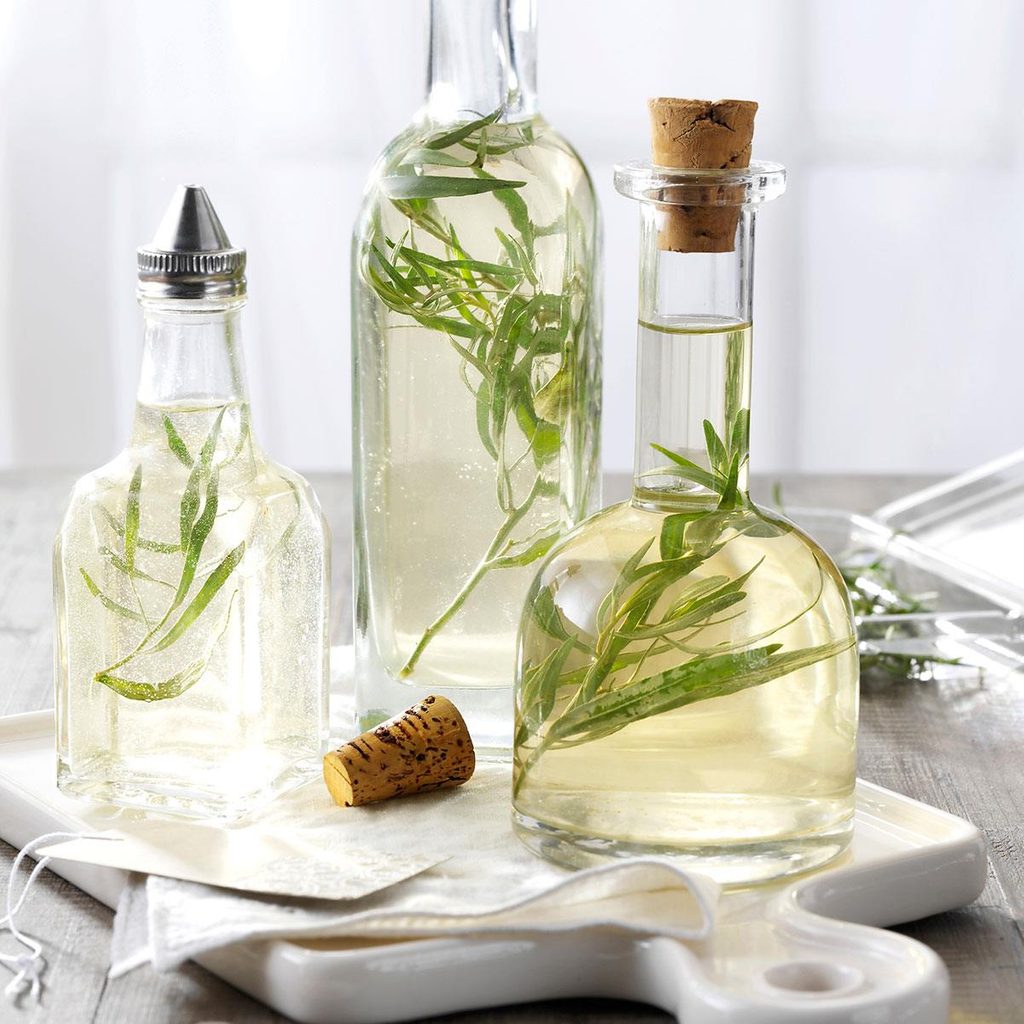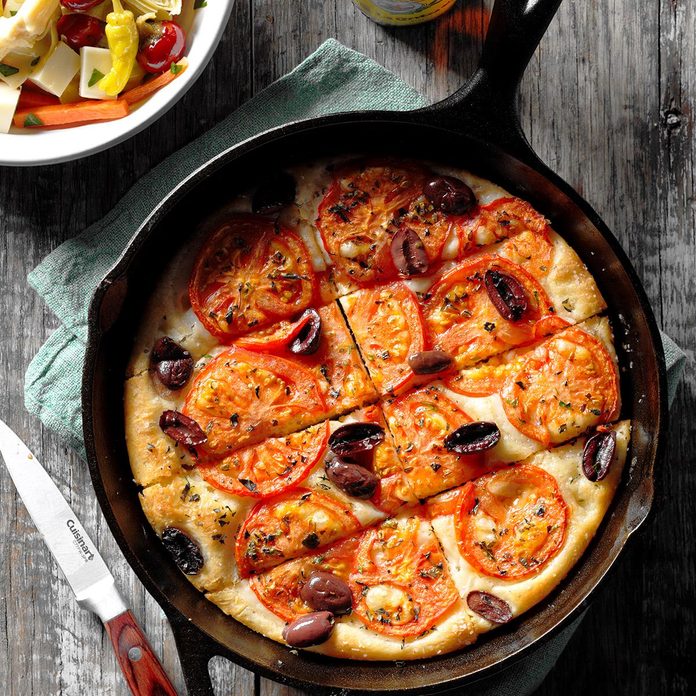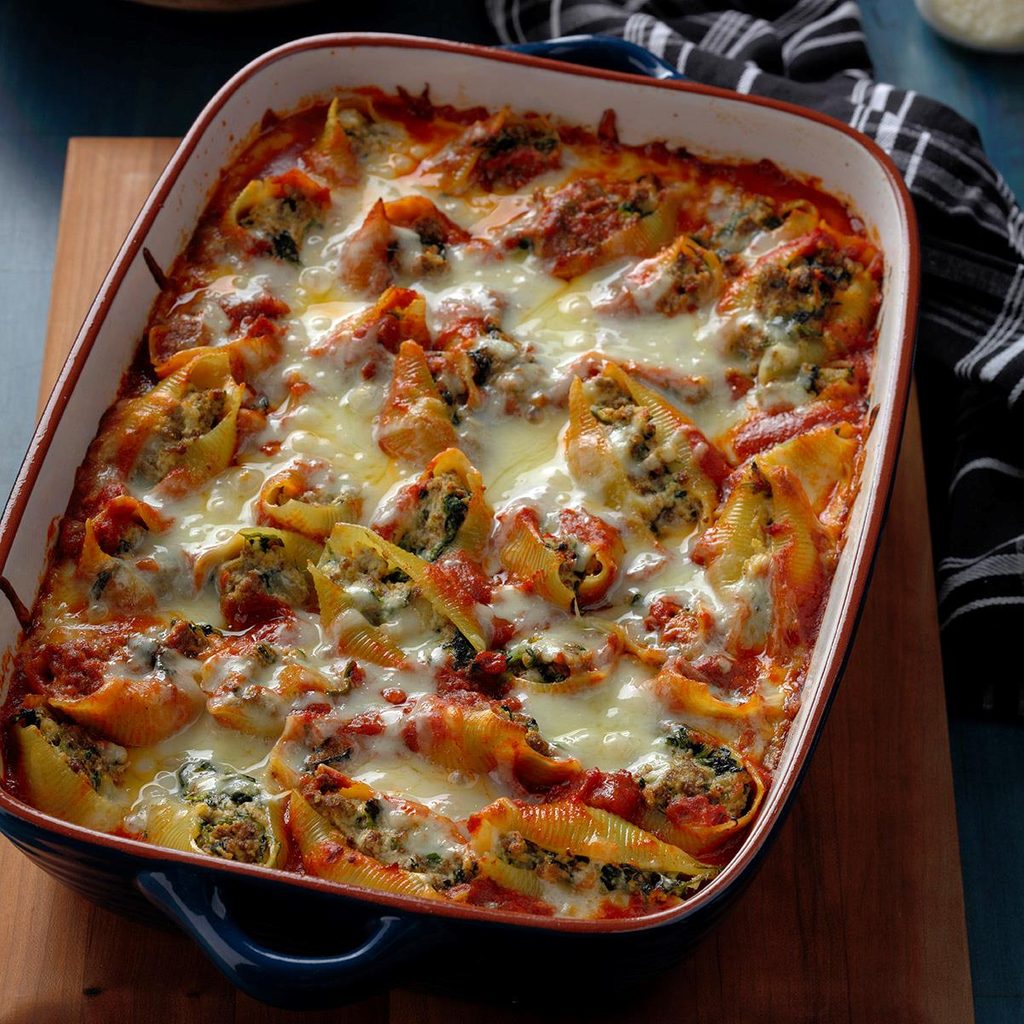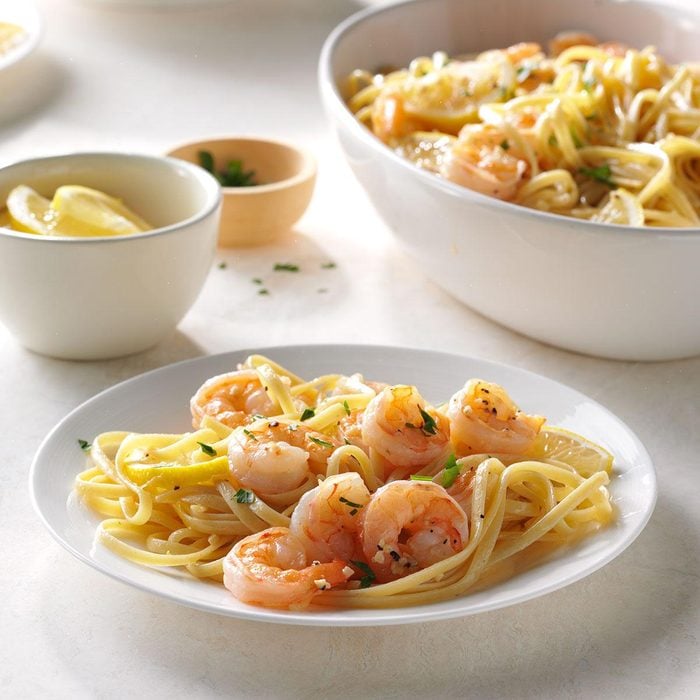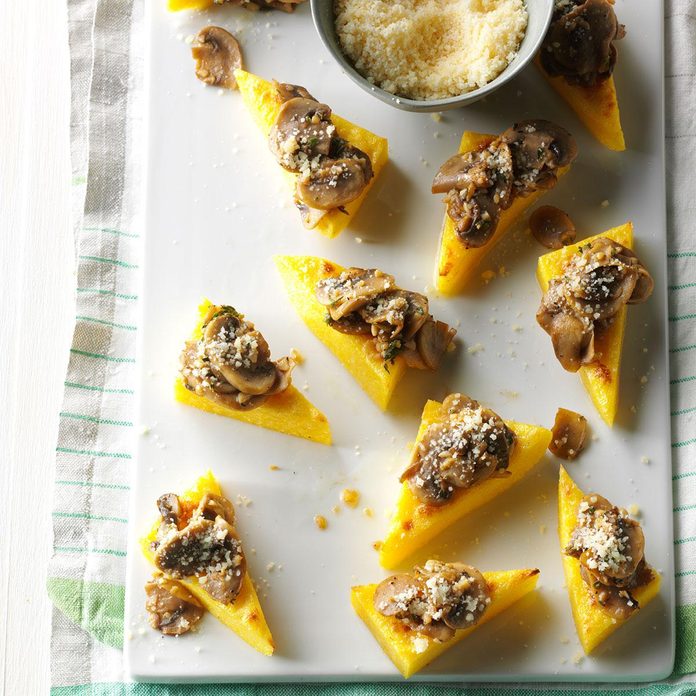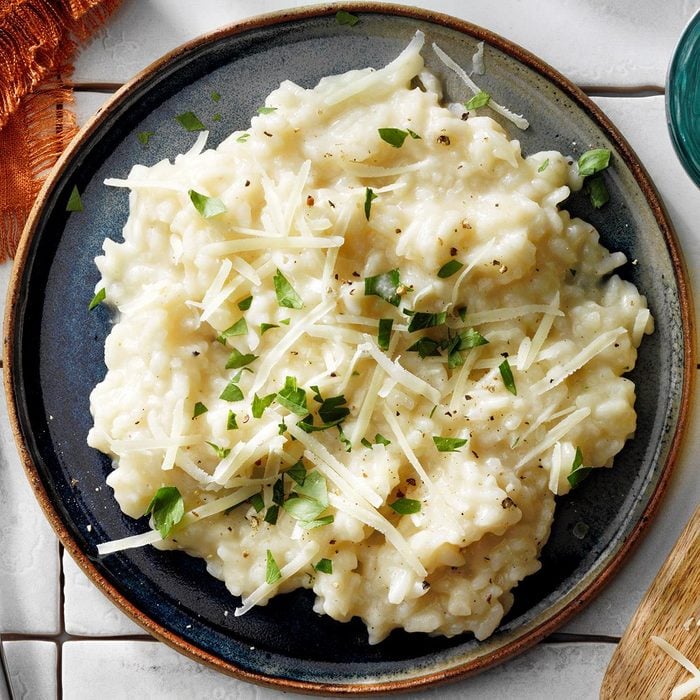 Taste of Home
Taste of Home
Once you've tried this tangy, yet delicate lemon chicken piccata, you won't hesitate to make it for company. Seasoned with parmesan and parsley, the chicken cooks up golden brown, then is drizzled with a light lemon sauce. —Susan Pursell, Fountain Valley, California
Get Recipe
Check out these
must-have Italian cookbooks for eating your way through Italy.
Stamp-of-Approval Spaghetti SauceMy father is very opinionated, especially about food. This recipe received his almost unreachable stamp of approval. I have yet to hear a disagreement from anyone who has tried it! —Melissa Taylor, Higley, Arizona
(Sop up this sauce with a piece of one of these
types of Italian bread.)
Italian BreadA basket of Italian bread complements any meal. Make your own loaves at home with our simple, straightforward recipe, then use them for sandwiches or just for sopping up some sauce.
Parsley PestoHomemade pesto always makes a thoughtful hostess gift. Mix things up with this parsley pesto variation. It's delicious served with pasta or in one of these
recipes using pesto. —Taste of Home Test Kitchen
Lemon GelatoThis fresh lemon gelato recipe is the perfect combo of tangy sweetness and a creamy-cold texture.
Authentic Pasta CarbonaraI learned on my culinary internship in Tuscany that real Italian cuisine is simpler than you think! This carbonara is quick, simple and delicious, just the way they like it in Italy. —Lauren Brien-Wooster, South Lake Tahoe, California
Traditional LasagnaMy family first tasted this rich, homemade lasagna recipe at a friend's home on Christmas Eve. We were so impressed that it became our own holiday tradition as well. I also prepare it other times of the year. This classic lasagna recipe is requested often by my sister's Italian in-laws—I consider that the highest compliment! —Lorri Foockle, Granville, Illinois
If you are looking for a quick recipe for the yummiest lasagna you can make Giada de Laurentiis's crispy sheet pan lasagna. And in case you have some extra time in hand, you must try Trisha Yearwood's cowboy lasagna, it is worth it!
Homemade ManicottiThese tender manicotti are much easier to stuff than the purchased variety. People are always amazed when I say I make my own noodles. My son fixed this recipe for several of his friends, and they were extremely impressed with his cooking skills. —Sue Ann Bunt, Painted Post, New York.
Don’t feel like cooking? Here’s our round up of the
best Italian restaurant in every state.
Chocolate BiscottiEasy chocolate biscotti comes together quickly thanks to boxed cake mix and chocolate syrup, and a drizzle of white chocolate finishes these twice-baked chocolaty treats.
Chicken Escarole Soup with MeatballsThis is an old recipe from southern Italy. My mother gave it to me when I was first married. It started out as a holidays-only dish...but my children and grandchildren love it so much that we have it every chance we get!—Norma Manna, Hobe Sound, Florida
Bruschetta ChickenWe enjoy serving this tasty chicken bruschetta to both family and guests. It just might become your new favorite way to use up summer tomatoes and basil. —Carolin Cattoi-Demkiw, Lethbridge, Alberta
Must-Have TiramisuThis is the perfect guilt-free version of a classic dessert. My friends even say that they prefer my lighter recipe over other tiramisu.—Ale Gambini, Beverly Hills, California
 Lisa Kaminski/Taste of Home
Lisa Kaminski/Taste of Home
Since I can’t hit up my favorite Italian bakery all the time, I had to find an Italian sandwich butter cookie recipe that I could make at home. Here it is. —Lisa Kaminski, Wauwatosa, Wisconsin
Go to Recipe
Oven-Roasted TomatoesI love tomatoes, as they're both healthy and versatile. You can use these roasted ones in sandwiches or omelets, or to top broiled chicken. —Julie Tilney (Gomez), Downey, California
Shrimp ScampiThis shrimp scampi recipe looks elegant enough to serve to company, but it’s easy to prepare. The bright flavors of lemon and herbs enhance the shrimp. Serve it over pasta and wait for the compliments. —Lori Packer, Omaha, Nebraska
Favorite Baked SpaghettiThis is my grandchildren's most-loved dish. It feels like a special dinner and is so cozy for cooler months. —Louise Miller, Westminster, Maryland
Chicken Pasta CasseroleThis is my family’s favorite every week or two and we never tire of it. I like that I can put it together and relax while it bakes. —Carmen Vanosch, Vernon, British Columbia
Italian Wedding CookiesYou don't need a party to enjoy these Italian wedding cookies. The soft, lemon-scented, cakelike cookies with a sweet glaze and pretty sprinkles make any day brighter.
Gnocchi with White BeansHere’s one of those no-fuss
gnocchi recipes you can toss together and cook in one skillet. Ideal for a busy weeknight, it’s also good with crumbled Italian chicken sausage if you need to please meat lovers. —Julianne Meyers, Hinesville, Georgia
If you are in the mood for some risotto too, try Ina Garten’s risotto recipe. It is easy to make with a heavenly taste.
Quick Focaccia BreadGreen olives complement this quick focaccia recipe for an easy pizza-like bread. With very few ingredients, it’s still packed with flavor. Serve the focaccia as an appetizer or alongside pasta, soup or salad for a mouthwatering meal.—Ivy J Laffoon, Ceres, California
Grilled Vegetable Salad with Poppy Seed DressingMy Italian-style grilled veggies have a wonderful sweet and sour dressing. Best of all, I pick the fresh veggies and herbs from my garden. —Laura Mast, Defiance, Ohio
Spring Green RisottoOnce a week I create a new recipe for my blog, An Officer and a Vegan. I first made this risotto when I needed something cheerful and comforting. It would be fantastic with asparagus, zucchini or summer squash, but use whatever veggies are in season. —Deanna McDonald, Grand Rapids, Michigan
Editor's Tip: Stanley Tucci has become a culinary sensation, try Stanley Tucci’s
Risotto Cakes which might be our favorite thing ever. And if you want to create magic with the leftovers? Try
Stanley Tucci’s pasta casserole’s recipe.
Special Slow-Cooked BeefThis hearty entree is easy to prepare for Sunday dinner. While the beef is slow cooking, the cook has lots of time to attend to the other details. With mashed potatoes on the side, it’s comfort food for the cool months ahead. —Juli George, Grandville, Michigan
Ravioli LasagnaOur four-ingredient ravioli lasagna is the perfect shortcut meal for when you're craving lasagna but don't have as much time to cook. It's an easy and delicious meal for any night of the week.
Zucchini ParmesanYou'll knock their socks off with this easy-to-prep side dish that's absolutely delicious. My favorite time to make it is when the zucchini is fresh out of the garden. —Sandi Guettler, Bay City, Michigan
Tender Italian Sugar CookiesThese traditional Italian cookies are moist and tender. —Weda Mosellie, Phillipsburg, New Jersey
BruschettaFull of simple yet bold Italian flavors, this easy bruschetta recipe is perfect crowd-friendly fare.
Creamy Roasted Garlic & Spinach OrzoThis side dish brings instant comfort. I first made it without spinach so my husband and daughter would like it. The next time, I added spinach for the extra health benefits. They still devoured it, so in my book that's a win-win. —Dawn Moore, Warren, Pennsylvania
Lasagna CasseroleAll the traditional flavor of lasagna, with none of the fuss. We've simplified the layers in this lasagna casserole so the dish comes together more quickly.
Canning Spaghetti SauceCanning spaghetti sauce is a delicious way to preserve garden-fresh tomatoes. Here's how to can spaghetti sauce in a water bath—no pressure canner required.
Italian Sausage with Bow TiesWe often have our favorite pasta when company comes over, and I’ve shared this Italian sausage recipe several times. Now many of my friends make it for their families, too. —Janelle Moore, Auburn, Washington
Cannoli CakeA luscious, chocolate-studded cannoli filling separates the tender layers of this rich cannoli cake, which (surprise!) starts with a packaged mix. Serve it chilled, with Italian red wine, as desired.
Skillet LasagnaSkillet lasagna is made in a single skillet and features creamy, cheesy layers full of classic flavors. The best part? No oven required.
Slow-Cooker Pizza CasseroleCrockpot pizza casserole is the recipe for a satisfying one-and-done meal. This comforting casserole with mass appeal is just what you need when cooking for a crowd.
Italian Lemon CookiesBright, light and full of citrusy flavor, these zesty Italian lemon cookies are a real treat. Top them with the simple colored sugar called for in this recipe, or switch it up with a glaze or frosting for a richer cookie.
Spumoni SlicesMy sweet rectangles get their name from the old-fashioned tri-colored ice cream. Our whole family prefers them. —Mary Chupp, Chattanooga, Tennessee
Four-Cheese Chicken FettuccineAs a cattle rancher, my husband's a big fan of beef. For him to comment on a poultry dish is rare. But he always tells me, "I love this casserole!" I first tasted it at a potluck; now, I fix it for my family (we have a 3-year-old daughter) once or twice a month, and I'm asked to take it to most every get-together. —Rochelle Brownlee, Big Timber, Montana
PizzelleThis recipe was adapted from one that my Italian-born mother and grandmother followed. They used old irons on a gas stove, but now we have the convenience of electric pizzelle irons. These delectable cookies are still a traditional treat in our family. —Elizabeth Schwartz, Trevorton, Pennsylvania
Artichoke Spinach LasagnaFriends of ours served this homey dish when we visited them in Maryland. We just had to get the recipe, and we have since added a few ingredients to make it even tastier. —Carole Rago, Altoona, Pennsylvania
Minestrone SoupThis minestrone soup recipe is packed with vegetables, pasta and beans in a bright tomatoey broth. It ticks all the boxes: It's hearty, incredibly comforting and a breeze to make!
Antipasto PlatterWe entertain often, and an antipasto platter is one of our favorite crowd-pleasers. Guests love having their choice of so many delicious nibbles, including pepperoni and cubes of provolone. —Teri Lindquist, Gurnee, Illinois
Tomato-French Bread LasagnaFor a big hearty meal, I make this recipe as a side dish to go with veal cutlets or a roast. But you could also serve the beefy lasagna as a main dish. Just pair it with a tossed green salad and loaf of garlic bread. —Patricia Collins, Imbler, Oregon
Italian Hot DishMy husband had a poor perception of healthy food until he tried this beefy casserole. The combination of pasta, oregano, mushrooms and green peppers makes it a favorite
healthy pasta recipe in our house. —Theresa Smith, Sheboygan, Wisconsin
Alfredo SauceKeep this creamy homemade Alfredo sauce recipe on deck for when you need a bowl of easy comfort food in less than 30 minutes.
Florentine Spaghetti BakeThis hearty sausage entree will appeal to just about everyone. My daughter serves it often to her hardworking family on their wheat ranch in Montana. —Lorraine Martin, Lincoln, California
Sausage ManicottiThis classic Italian entree comes together in a snap but tastes as if it took hours. It's so tasty and easy to fix. My family always enjoys it. —Carolyn Henderson, Maple Plain, Minnesota
Artichoke Chicken PastaThis artichoke chicken pasta combines tender chicken, crisp veggies and a creamy sauce for a delicious meal that feels restaurant-worthy, all made in your kitchen. It's easy to customize with your favorite vegetables and can be adapted for various dietary needs.
Sausage Bean SoupYou’re moments away from a flavor-packed soup that keeps you warm on even the chilliest nights. It's just the kind of recipe we Minnesotans love. —Marlene Muckenhirn, Delano, Minnesota
Cheese Tortellini with Tomatoes and CornFresh corn and basil make this dish taste like summer. I think it's a good one for bringing to picnics or gatherings, but it's great along with any side dish for a weeknight dinner! —Sally Maloney, Dallas, Georgia
Italian Herb and Cheese BreadsticksThanks to convenient frozen dough, these delectable breadsticks are oven-ready in 20 minutes. The cheesy bites are so good dipped in warm marinara sauce. —Rebekah Beyer, Sabetha, Kansas
Lasagna DipMy lasagna noodle chips turned out great and are out-of-this-world crispy. And the dip truly tastes like rich, cheesy Italian-American lasagna. —Linda Cifuentes, Mahomet, Illinois
Grilled Pears with Mascarpone CheeseFor a light dessert after a big barbecue, we stuff pears with mascarpone cheese and gingersnap cookies. Add a drizzle of caramel sauce for a sweet touch. —Faith Cromwell, San Francisco, California
Tangerine Chocolate SemifreddoWhen I wanted a new frozen treat for my family, I came up with this citrusy, chocolaty version of classic Italian semifreddo. For an elegant presentation on special occasions, top each serving with whipped cream, a tangerine section and baking cocoa. —Claire Cruce, Atlanta, Georgia
Grilled Garden Veggie FlatbreadsGrilled flatbread is a tasty way to put fresh garden vegetables to use. It's so versatile: Simply change the vegetables and cheese to suit your family's taste. It also works well cooked indoors, on a grill pan with a lid. —Carly Curtin, Ellicott City, Maryland
Marinated Almond-Stuffed OlivesMarinated stuffed olives go over so well with company that I try to keep a batch of them in the fridge at all times. —Larissa Delk, Columbia, Tennessee
Sweet Almond TwistsThese delicate almond pastries make lovely light-as-air accompaniments for coffee, tea or cocoa. Your guests will never guess the recipe calls for packaged frozen dough. When I give them as a fresh-baked gift, I tuck in a note saying that they're best served warmed—and right away! —Gloria Devendittis, Waterford, Connecticut
Farmers Market Orzo SaladOrzo is a tiny pasta shaped like rice. We use it as a base for veggies, lemony vinaigrette and cheeses such as mozzarella, feta or smoked Gouda. —Heather Dezzutto, Raleigh, North Carolina
Asparagus Shrimp LinguineMy family really enjoys asparagus and shrimp. We often have this on busy weeknights because its healthy and cooks quickly. —Ehnes Wannetta, Eagle Bend, Minnesota
White Bean Arugula SaladMy red, white and green salad is inspired by the Italian flag. Top it with shaved Parmesan. —Malia Estes, Allston, Massachusetts
Antipasto SkewersAntipasto skewers—the finger-friendly Italian kabobs with marinated vegetables, cheeses and tortellini— are precisely what you need for your next gathering. Mix and match your favorite ingredients for a unique and varied spread.
Meatball Submarine CasseroleWe were hosting a bunch of friends, and after a comedy of errors, I had to come up with a plan B for dinner. I realized that much-loved meatball subs are even better as a hearty casserole—so delicious! —Rick Friedman, Palm Springs, California
Fennel Salad with Orange-Balsamic VinaigretteA sweet balsamic vinaigrette always pulls everything together in a delicious harmony of flavors. Raspberries are one of my very favorite fruits, so I'm always eager to find a new use for them. —Susan Gauthier, Falmouth, Maine
Hot Chocolate TiramisuInstead of using coffee and rum, I let cinnamon shine in this tiramisu. It's best if eaten within two days—if it even lasts that long! —Cathy Geniti, Saratoga Springs, New York
Limoncello Cream PieAfter a big Christmas dinner, we love the cool refreshment of a frozen lemon pie. Limoncello brings a little sophistication to each smooth, creamy slice. —Jessie Grearson-Sapat, Falmouth, Maine
Sausage & Mushroom Pizza FrittataI love this frittata because the combination of fresh flavors makes it special. It's the perfect sunny South Florida breakfast.—Wolfgang Hanau, West Palm Beach, Florida
Meaty Arugula PizzasWhen I was growing up, my mom always made homemade pizza every Friday night. We'd watch a movie as a family or have friends over, too. Now that I'm married, I carry on the pizza tradition. —Morgan Harvey, Longview, Washington
Crunchy BreadsticksThese thin, crisp breadsticks created in our Test Kitchen add a bit of elegance to a holiday dinner. Each bite is perfectly seasoned with thyme and coarse salt.
Arugula & Mushroom Breakfast PizzaIt's a challenge to be creative with breakfast every morning, and I like to come up with fun foods the kids will love. This is a great recipe for the kids to join in and help make for breakfast. You can also make and freeze it before you add the eggs, then finish baking another day. —Melissa Pelkey Hass, Waleska, Georgia
Spaghetti Meatball SupperIt was such a joy to come home and find my mom making spaghetti and meatballs for dinner. This recipe has always been dear to my heart. —Debbie Heggie, Laramie, Wyoming
Cioppino-Style SoupThis classic San Fransisco soup makes an easy, healthy and flavorful dinner. I serve it every New Year's Eve, and I'll often include salmon along with the cod, shrimp and crab. —Nancy Heishman, Las Vegas, Nevada
White Beans and SpinachThis skillet side is a variation of a recipe I received from my Italian mother. I've prepared spinach this way for years—because my children eat it happily! —Lucia Johnson, Massena, New York
Mascarpone-Mushroom Frittata StackWhen I bring this delicious egg dish to the table, I always get oohs and aahs! It looks impressive but is quite easy to prepare.—Gilda Lester, Millsboro, Delaware
Double-Drizzled BiscottiSemisweet and white chocolate drizzles give these biscotti a pretty look. The baking time is shorter than for some biscotti, so they're a little softer. —Cheryl Ludemann, Boonville, New York
Zucchini & Cheese RouladesMy husband enjoys this recipe so much that he even helps me roll up the roulades! You can change the filling any way you like—I have used feta instead of Parmesan, or sun-dried tomatoes in the place of the olives. —April McKinney, Murfreesboro, Tennessee
Brownie Affogato SundaesWe can’t resist brownie sundaes. I combined an affogato (coffee-based beverage) idea with a brownie to get this decadent sundae that mixes it all in there: warm, cold, sweet and salty. —Julie Merriman, Seattle, Washington
Frittata FlorentineMy family is all about brunchy meals like this gorgeous Italian omelet. Lucky for us, it’s loaded with ingredients we tend to have at the ready. —Jenny Flake, Newport Beach, California
My Best Spaghetti & MeatballsOne of my favorite childhood memories is going to the Old Spaghetti Factory with my family and ordering a big plate of cheesy spaghetti, meatballs and garlic bread. My homemade recipe reminds me of those fun times and satisfies everyone's craving for good Italian food. —Erika Monroe-Williams, Scottsdale, Arizona
Chicken Meatball SoupChicken meatball soup is a brothy, comforting bowl of vegetables with savory chicken meatballs and tender white beans. A smart shortcut ingredient, boxed stuffing mix, is the secret to flavorful meatballs that stay tender in the soup.
Amaretto Ricotta CheesecakeThere's a good reason why a relative handed this cherished recipe down to me. It's a keeper! The amaretto and ricotta make for a truly unique dessert. —Isabel Neuman, Surprise, Arizona
Almond-Ricotta TwistsA very dear friend gave me this recipe so I make these to remind me of our time together. I like to drizzle melted white chocolate or chocolate chips on the baked cookies.—Paula Prechtl, Brockport, Pennsylvania
Spaghetti with Fresh Tomato SauceWhen my mom made this spaghetti sauce, the house would smell so good that I'd open the windows to torture the neighbors. It even tastes wonderful the next day, when the flavors have really melded. —Vera Schulze, Holbrook, New York
27 Recipes for Anyone Who Loves PestoWhether you bought a jar of prepared pesto or have some fresh herbs laying around, enjoy our favorite recipes using pesto. We found delicious ways to include it in appetizers, dinners and even pizza!
Creamy Garlic-Lemon ChickenI needed an easy way to prepare my family's favorite meal, lemon chicken, and this recipe is it! My entire family loves this rich slow-cooker dish, and everyone who eats it asks for the recipe—it's a keeper. I serve the chicken over a bed of rice or couscous and spoon some of the creamy sauce over the top.—Nan Slaughter, Sammamish, Washington
Chicken Cacciatore with PolentaThe microwave makes quick work of homemade polenta, and the rest is done in one skillet. Save a little Parmesan for sprinkling on top before serving. —Yvonne Starlin, Hermitage, Tennessee
Pumpkin TiramisuPut a twist on a classic dessert just in time for fall. Learn how to make pumpkin tiramisu filled with cozy flavors.
Herbed VinegarThis herb vinegar would be a great addition to your favorite salad dressing or could be used in place of vinegar in any recipe. The terrific flavors of tarragon and basil really shine through. —Taste of Home Test Kitchen, Milwaukee, Wisconsin
Focaccia BareseThis focaccia has been in my mom's family for several generations. It is one of my most-requested recipes whenever I am invited to a party—I am not allowed to attend unless I bring it! —Dora Travaglio, Mount Prospect, Illinois
Stuffed Shells with Arrabbiata SauceThis Italian classic takes on a distinctive Latin American flourish with the addition of chorizo. The sausage adds an extra kick and awesome flavor to a dish that's already a favorite. —Crystal McDuffy, Fairfax, Virginia.
Lemon Shrimp LinguineI like recipes with elegant taste and easy technique like this lemony shrimp pasta. Bring on the Parmesan and a sprinkle of red pepper flakes. —Patty Walker, West Des Moines, Iowa
Polenta Mushroom AppetizersSimple ingredients—in fact you probably have most if not all in your kitchen— are used to create a fantastic, but different appetizer.—Meta West, Abilene, Kansas
Parmesan RisottoRisotto is a creamy Italian rice dish. In this version, the rice is briefly sauteed, then slowly cooked in wine and seasonings. Watch for that magic moment when the risotto transforms from just rice in liquid to creamy, tender deliciousness. —Taste of Home Test Kitchen
Next: Try
Ina Garten’s summer garden pasta’s recipe.
Lobster alla DiavolaI’ve cooked lobster alla diavola (devil’s style) since I was first married. We serve lobster at family celebrations, usually with linguine or capellini. —Marcia Whitney, Gainesville, Florida



